#deva cut
Text



helpful overlord of darkness
#danganronpa 2#sdr2#gundham tanaka#hajime hinata#dr2#if he cuts his villain monologue to help you it means you achieved friendship#if he lets you hold the devas it means you’re close friends#if he asks you to name a baby animal you’re on a whole another level
364 notes
·
View notes
Note
Tbh I think the whole class should get to smooch hajime. It’s what he deserves
im imagining hajime sitting in a kissing booth looking like lucy from peanuts in her psychiatrist booth. kisses are 5 cents. the hajime is IN.
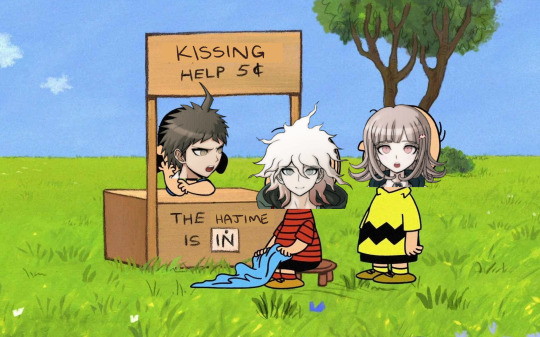
#hajime deserves the love <3#LMAO im trying to imagine the line up>>#teruteru BOLTS for the front but quickly gets crowd surfed to the back of the line. chiaki is in line too but she's getting distracted#by her game and isn't moving forward so whoever's behind her just cuts. kazuichi is like 3rd in line bc logically speaking#if he's FIRST in line he'll look THIRSTY for his BRO and that would be CRAZY! BUT!!! no way he's gonna be LAST that's his SOUL BRO ok#if anybody deserves haji bro kisses around here it's HIM!!! 😤#nekomaru finds it to be a great team building exercise!! remember to kiss with your CHEST!!! 💪🏼 akane thinks it's a competition of sorts#OOPS so she tries to give hajime the Strongest Kiss Ever. does not go well but her enthusiasm is appreciated 👍🏼#ibuki will get a kiss and then run BACK in line to see if she can sneak another one :3c#gundham kisses hajime WITH TONGUE!!!!! lmao jk gundham would definitely be like 'nobody touch me >://(' but eventually....#he sends his sneakiest Dark Deva to run up to hajime and steal a kiss when nobody is looking... >://)c kheheheh!!#nagito is content with remaining last in line bc he's just happy to see his classmates having their little hopeful moment :) without him :)#(he does eventually get his kiss tho dw)#and uhh if you give mahiru like a dollar she'll take a pic of the kiss LMAO#ALRIGHR ALRIGHT I GOTTA STOP this is too long. god. appreciate this fucking post anon 🙏🏼#sdr2#danganronpa
38 notes
·
View notes
Text
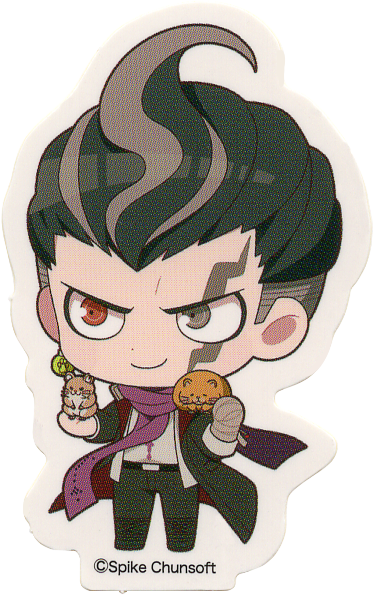


⋆⭒˚。⋆ Danganronpa 1/2 Reload x Master Detective Archives: RAIN CODE CollaboCafé Sticker [Vol.2] (ft. Gundham Tanaka) ⋆。˚⭒⋆
[ Filled + adjusted/original die cut ]
#ScanEverything#OfficialEverything#Danganronpa#Super Danganronpa 2#Danganronpa 2: Goodbye Despair#Gundham Tanaka#Dark devas#Four Dark Devas of Destruction#SDR2#Spike Chunsoft#Sticker#Die-cut sticker#Video game merch
23 notes
·
View notes
Text
💜The SDR2 Boys with an S/O who is drop dead GORGEOUS💜
[🍓]

Basically the sdr2 boys with an S/o who is just..perfect. Just absolutely beautiful, stunning, gorgeous.
🍊Hajime Hinata🍊
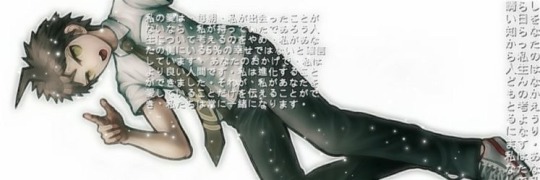
Oh. My. Fucking. God.
He is absolutely losing it.
He has never seen someone so beautiful like what the actual hell-
Hajime would be SO nervous to even go up and talk to you. Like he feels as if he isn’t good enough to even walk up to you.
When he finally gets his head out of his ass and talks to you, he’s a blushing mess and he’s stuttering while your just there like:ヾ(〃^∇^)ノ
He cant even look you in the eye.
Your beauty is too damn bright what the hell
When y’all start dating, he kinda has more control over how he gets around you since now he’s gonna be seeing you everyday!!
Sometimes he wonders why you would even care to date a plain guy like him while your just a walking model everywhere you go
He ain’t complaining though
on y’all’s first ever date he is anxious, like he’s sweating bullets.
what can y’all do on a island during a damn killing game
Like he did NOT know what to do or how to plan a date with you. He just did not know because he was everything to be absolutely perfect.
He was so relieved when you said that you didn’t care where y’all’s date was, just as long as your with your boyfriend then that’s all that matters
In conclusion, Hajime loves you deeply. He was kinda anxious and nervous when he first talked to you but now since you two are dating he’s more open to you. He doesn’t just love you for how beautiful you are, but he loves you for your personality. He loves you inside and out and that’s all that matters to him.
🍀Nagito Komaeda🍀
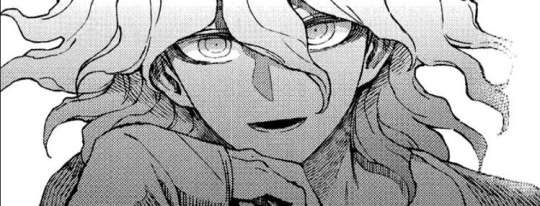
Okay-
…he’s more open to you when you first talk. But MANNNNN…he is cutting himself UP.
Like he feels like he doesn’t even deserve to be talking, breathing, looking, eating, or ANYTHING near you cause like your just…DAMN.
“Of course, a lowly person like me shouldn’t be talking to someone as gorgeous to you.”-SHHHH
He just can’t take it with you. Your just so MWAH.
Despite all the harsh things he says about himself, he actually is in love with you but is to scared to ask you out because…yeah.
So your gonna have to make the first move-but dont even worry about it girl. He’s not would, or is…he WILL say YES. Don’t even stress about it cause your gonna get that Y-E-S.
When y’all are dating, he treats you like a princess🩷
He loves you sm, despite being on a killer island he still tries to make it very loving and fun with you
Lots of hugs and kisses and compliments from him while degrading himself
You remind him so many times to the point where you lose count that he’s not trash and that he deserves all this love from you
He cant help it, at all
The date is at the beach. y’all play in the ocean and splash each other
In conclusion, he tries. He tries to make sure that you have fun and your always have a good day with him. Yes, he may be a handful with his comments about himself and..a little crazy in general but you don’t let that get in the way of your relationship. You love him, he loves you, you both love each other.
🐹Gundham Tanaka🐹

Definitely calls you a Queen of some sort.
Easily gets flustered around you and when talking to you.
Occasionally, compliments you and addresses you by calling you (whatever) Queen when mentioning you.
He allows you to pet his Four Dark Devas, the Dark Devas loves you sm
When he’s ready to confess, he would make it romantically dramatic but it’s also so cute. Of course you accept his confession and you guys are now a sweet couple.
He is so blessed to have you
On y’all’s first date is romantically special, it’s filled with you guys spending time together for the whole day holding hands and enjoying each others presence.
You guys sometimes sleep with one another. The dark devas would sleep on different places on you. Such as your head, waist, in the crook of your neck and even sometimes on your face. it’s really funny when you wake up with a sleeping soft hamster on your face, making you smile and laugh.
He loves your smile, your laugh, everything. Everything about you brings him love and joy
He tells you about his Ultimate, you happily listen to him as the dark devas lay on your head.
In conclusion, you two are very close. There’s funny times, happy times, and even awkward times with the two of you but even so, it’s great. It’s filled with so many things, things are new everyday with each other.
🔧Souda Kazuichi🔧
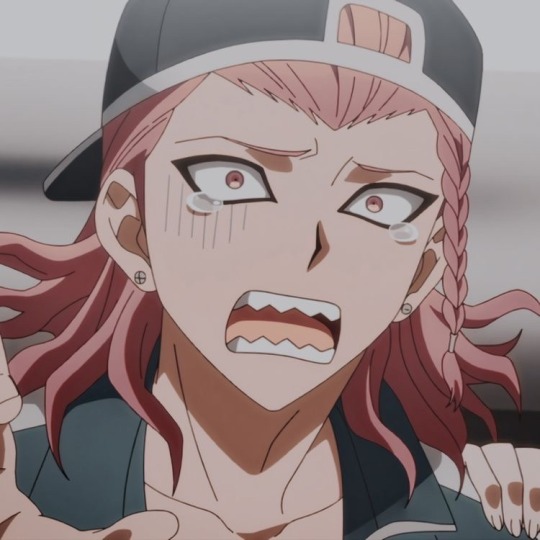
Where do I start…
Oh lord, OHHH LORD.
* chef kisses* He loves you. He is acting like how he was acting with Sonia.
He was kinda stuck on Sonia for a bit but he fell into your hands. He is an actual simp for you it’s not even funny at this point.
Compliments on the daily, ON THE DAILY.
Even when you look tired, all messy from bed hair he is still complimenting you regardless.
He treats you like a queen, he helps you so much, he is just blushing everytime you guys make eye contact or chat.
It doesn’t matter who confesses but…it would be you. Souda is very open to his crush on you, VERY open. He tells the others about you, talks about you constantly, thinks about you-
When you confess it’s a dream come true.
He hugs you so tight as he rambles on about how he also has a crush on you and tells you all of his feelings, which you weren’t listening to because you knew from the very start.
The date is fun ngl.
Y’all go to the beach, he buys you things from the store, you eat together (involves Souda yelling at TeruTeru for flirting with you)
Everything is just exciting.
You allow him to play with your hair when your bored or just for fun.
You guys laugh A LOT.
He gives the BIGGEST and BEST hugs and kisses. Like with kisses, he just kisses you all over. With hugs, it’s the most coziest, tight, hug you ever receive and it will be forever. It’s just amazing.
In conclusion, Y’all’s relationship is beautiful in its very own way. He’s a great boyfriend and is actually really happy that you have the same feelings for him as he does with you. It makes him happy that you would choose him over any guy whose probably better than him. Their not, in your eyes and heart he is the one for you.
💛Fuyuhiko Kuzuryuu💛

Like always, he is a bitch on the outside..always and forever will be:.
But he is absolutely CRUSHING on you on the inside.
He tries to stay FAR away from you as possible, dragging Peko along with him.
Of course, Peko notices this and figures it out pretty easily that her master is crushing on you. She asks Fuyuhiko about it and of course he denies it completely but eventually gives up and admits that he is head over heels over you.
When you two finally talk (Peko was encouraging Fuyuhiko too be the one to talk to you due to him just running away) he is very bashful and stammering over his words as he curses at himself in his head.
You find this cute but you don’t want to get him all pissy cause this is the first time you guys talked and you noticed how he scrambled away when you try to talk to him.
After you guys talk a little more, a little more turns into more. He starts getting even more stressed about his insane crush on you.
Peko has to help him out with this and helps him confess his feelings for you.
He’s tsundere how you accepted his feelings for you and told him about yours but really, he is relieved that you accept his feelings and is losing his shit on the inside.
Peko helps him set up a small date at the cabin and tells everyone just to not bug y’all. God bless her.
You guys are food and chat happily, laughing and teasing one another in a playful manner. The date was a successful, funny, and playful time for the both of you and you guys enjoyed every single second, minute, and hour.
You guys hang out together most of the time.
Peko joins along and you two got closer of course, becoming the best of friends.
When Peko sadly passes away, you comforted Fuyuhiko and hold him close as you cried too. Despite this inconvenience, you two manage to stay close and be there for one another. Even when he had slit his own stomach. You were worried for him and stuck by his side in til he was better.
in conclusion, your love for one another is beautiful. It’s strong and lovable. You make sure that both of you are okay with all that’s happened and hold each others hand throughout it all, not losing or drifting away from one another. It’s a blessing, a hope, a wish. Something that’s beautiful.
#danganronpa x reader#nagito komaeda#sdr2 hajime#hajime hinata#nagito headcanons#nagito my beloved#danganronpa nagito#hajime headcanons#danganronpa x y/n#danganronpa x you#nagito x reader#nagito x y/n#dr nagito#kazuichi souda#souda headcanons#gundham x reader#danganronpa gundham#sdr2 gundham#gundham tanaka#fuyuhiko x reader#fuyuhiko kuzuryu#sdr2 fuyuhiko#headcanons#danganronpa headcanons#fluff#[🍓]#A little bit of angst#angst with a happy ending#sdra2 x reader#x reader
1K notes
·
View notes
Text
Who's THE Devil?
You know, from, like, The Bible?
One of the things the various takes on Hell more or less agree on is that there is one demon among the legions of Hell who more or less reigns supreme - The Devil with a capital The. What they rarely agree on, however, is which devil that is. So, for funsies, let's look at all the candidates for The Devil, shall we?
Belial
The concept of demons arguably predates Abrahamic religions, at least if we take it at its most nebulous definition of "supernatural people from an Other world who are somewhat antagonistic toward humanity." But the more specific and probably more familiar version of them began with The Book of Enoch, one of many texts that were deemed non-canonical by Christians yet still holds a great deal of influence on Christianity as a whole. It's an extended account of the Noah story, positing that a group of angels rebelled against heaven because they wanted to sleep with mortal women, and created a race of giant half-human half-angel offspring called the Nephilim (Goliath, of David and Goliath fame, was one of the nephilim). God wasn't happy with this, and sent the rebel angels to a fiery pit before killing most of the nephilim with the big ol' flood (though Goliath's lineage survived somehow I guess).
It's not quite how most people picture the War in Heaven and rebellion of the angels, but it's nonetheless where that story started, and that makes it important. This is the first take on what would become the classic origin story for demons and Hell itself. And who is the leader of the rebel angels in this story? Why our good friend Belial, of course. Belial would remain a prominent demon from hereafter, but despite having the earliest claim for the crown of The Devil, Belial has not remained the frontrunner in the race, and is generally demoted to just being a high ranking demon, rather than the Highest ranking one.
2. Beelzebub
I've talked about Beelzebub before and I don't want to spend too much time rehashing that post, so brief recap: Beelzebub began as a mean nickname for a god from a rival religion to Judaism who was named Baal Zebul, which means Lord of the Heavenly Place. Baal Zebub, by contrast, means "Lord of the Flies." Eventually Baalzebub becomes Beelzebub and, divorced from the original context of its creation, becomes a character in his own right, being a prominent demon. And because Beelzebub appeared in a lot of texts, many of them very old as demonology go, he became a major competitor for the title of The Devil, and remains so to this day. I think it's partly because the name "Beelzebub" is really fun to say, but the sheer history and volume of demonology texts portraying him as a big, powerful devil also help. In the rare stories where Beelzebub appears but does not get to be The Devil, he's still portrayed as fairly high ranking, with both Milton's Paradise Lost and Marlowe's Faust making him The Devil's right hand demon, second in command of Hell. So even when he loses the crown, Beelzebub takes home a good silver medal
3. Asmodeus
Asmodeus is another of our "predates Christianity" demons, right up there with Beelzebub and Belial, and as far as I can tell from what I've read he was originally intended to be The Devil rather than just a devil. It's kind of right there in the name - "deus" means god, so Asmodeus having that name marks him as a demon who thinks himself equal to God.
(well, ok, there's some debate about the full origin of his name, with some arguing the "deus" part was originally a play on "deva," which in turn is loosely translated as... demon. The fact that Asmodeus's name is pronounced/spelled differently to a preposterous degree is part of why the water is so muddy - Asmoday, Asmodai, Asmodee, Osmodeus, it goes on and on)
One of his better claims to the crown comes from the story of Solomon - you know, the wise king who told people to cut babies in half. Solomon's less canonical feats include enslaving a shitload of demons to build a temple for him by way of the rite of exorcism, using a magic ring and the power of Christ to compel the damned to do manual labor for him. Asmodeus is specifically stated to be the strongest demon he summons in part because he is the King of all Demons, i.e. The Devil - and the other demons weep at the sight of their king being reduced to a slave by mortal hands.
Why is this a strong claim? Because the story of Solomon in turn inspired The Lesser Key of Solomon, a text about using the rite of exorcism to summon and use demons to do your bidding. The Lesser Key of Solomon includes the Ars Goetia, which is basically a big ol' bestiary of demons, and where many of your favorite pop culture demons - like, say, Stolas the owl guy - come from. Being the King of all demons in the story that inspired one of the more thorough and exhaustive lists of demons and their hierarchies should count for a lot.
There's one other great claim to fame Asmodeus has in his favor. While not directly named in Dante's The Divine Comedy, the description Dante gives of Satan's physical appearance matches with the most popular descriptions of Asmodeus - in particular, his three heads, one of which is yellow, one red, and one black. Granted, it'd be more of a smoking gun if one of those heads was a bull and the other a goat, but they're all very ogre-like, so I still think it stands. Dante's Devil is, more likely than not, Asmodeus, and that's a BIG point in Asmodeus's favor.
4. Hades/Pluto
Ok, so, a great deal of the Old Testament was originally written in Greek, and the New Testament was written in Latin, both of which happened when belief in the Olympian Gods was pretty strong. As such, the word "Hades" appears in the Bible a lot when talking about the place where dead people go, though it probably wasn't meant to literally be the same underworld as that in Greco-Roman mythology. Probably.
But because Christianity was spread primarily by the Roman empire once they converted to Christianity, and because Europe ended up getting a centuries-long case of stockholm syndrome for the Roman Empire that involved many people in power declaring that Greco-Roman mythology was super important literature and Latin was the language of God Himself, there is a good chunk of Biblical apocrypha that treats the use of Hades as, well, a literal crossover of sorts. Which is to say that Hades the god is sometimes treated as, like, a figure in Christianity, generally a demon specifically. And because he's, you know, Hades, from, like, The Odyssey, people feel he needs to be prominent. I mean, Hades RULED the underworld in Greek mythology, so if we're stealing him for Christian folklore, he should at least be in upper management, right?
The strongest case for Hades being The Devil comes from The Book of Revelation, one of the few books in the Bible that actually contributes to demonology (despite what people tell you, demons really don't show up in the Bible that much - most of what we think of as iconic demon lore come from non-canonical works). You know the four horsemen of the apocalypse? War, Famine, Plague, and Death, right? HA, WRONG! It's Conquest, War, Famine, and Pestilence & Death, you fake horseman fan. Well, anyway the line that introduces Death/Pestilence & Death ends with "And Hell followed with him." Except, no, not really, because the specific word used is... Hades. "And Hades followed with him." Which, depending on how you want to interpret the line, could very well mean a literal, King of the Underworld Hades.
Of course, the problem with using Revelation as proof is that Revelation itself is pretty unclear on who's leading the forces of evil. Is it the Seven-Headed dragon who's cast out of Heaven at the beginning of the end of the world? Is it the seven headed leopard monster that the dragon gives his crown to? Is it the monster who crawls out of the ground to speak for the seven-headed leopard with the voice of a dragon? Is it Hades? Is it God, the one who's allowing all this violent shit to happen and frequently sending his angels to make it way fucking worse? Who can say.
So, while it's not super common, there are more than a few works where The Devil is none other than Hades himself. Disney... might not have been completely off the mark, I guess?
While I think Hades's claim is pretty weak, I should note that one of the works that puts a LOT of Greek mythology into Hell is none other than Dante's The Divine Comedy. 70% of the demons in Dante's Hell are just Greek monsters, with the remaining few being Asmodeus and some OC demons he made up with portmanteu names a la Pokemon. Notably, Hades is one of those demonized Greek figures - presented as the Judge who decides where in Hell sinners end up based on their crimes. He's not The Devil, though, so while Dante kind of helps Hades's case, he also kind of ends up making a counter argument to it.
5. Abaddon/Apollyon
Ok, so, the word "abaddon" is used in some texts to refer to Hell, and sometimes it's personified as well. It literally means "ruin." Well, in time, Abaddon is personified and become a demon, which should feel like a familiar story to you by this point. And because Abaddon can also literally be Hell itself, it's only natural that some stories posit Abaddon the demon as the rule of Hell, much as Hades is the ruler of Hades in Greek mythology. This is Abaddon's big claim, and it's not bad, but it's not super strong. Nonetheless, it was enough for at least one prominent Christian text, Pilgrim's Progress, to make Abaddon (under one of his synonym names, Apollyon) to be The Devil, so we can give him that too.
6. Sheol
The sections of the Bible that are written in Hebrew use the word "Sheol" to refer to the underworld/afterlife rather than Hades. Now, Judaism doesn't have the same Hell as Christianity, or the same concept of Heaven either for that matter, and Sheol is less a place of torment for the damned and more of a waiting room for the dead to hang out in until the Messiah comes.
Nonetheless, Sheol did get personified like Abaddon and Hades, and that personification (which, in some versions, is a batty old lady, which is fun) later became a demon in its own right, and thus, for the same reasons as Abaddon and Hades, has a claim to being The Devil by dint of also being, you know, Hell itself. Not the strongest, most popular claim, no, but a claim nonetheless.
7. Satan
Feels rather obvious, doesn't it? Ok, so, in The Bible, one of the characters who was retconned into being The Devil is the angel in the Book of Job who takes on the title of Satan. In the original context of the story, "Satan" is not a name, but, again, a title - a job title, really, roughly akin to "prosecuting attorney." The Satan in the Book of Job isn't a rebel angel, but an angel whose job is to argue for the opposing view point to make sure everyone is doing the right thing. Less "The Devil" and more "the devil's advocate."
But! Christians fucking LOVE the devil, and they want more devil in their Bible, so many translations treat (the) Satan not as the hard-working servant of God he was originally written as, but as, you know, The Devil, arch-enemy of God and justice. And so Satan becomes synonymous with The Devil, and over time more and more appearances of The Devil give him the name Satan.
I can see an argument for this being the strongest claim, because the sheer amount of works where "Satan" is treated as The name of The Devil is enormous. But I think it's important to note that many of those works actually treat it as a name for the devil, which is to say, not the only name. I guess a lot of modern works think the name is so commonly used that it lacks its punch, and so they have The Devil pull the "I have many names" schtick to sound more imposing.
8. Lucifer
So there's a part of the Bible that talks about a star falling out of Heaven as a sort of metaphor for how people can fall from grace. Well, good ol' King James translated this as not just a falling star, but specifically The Devil himself, giving him the name Lucifer, which means "light-bringer." The King James translation of the Bible is bad in that it's immensely inaccurate, but good in that it's a beautiful piece of poetry in its own right, and since it had the authority of a goddamn king behind it, it quickly became a prominent Christian text and is still the preferred translation of many Christian sects to this day.
So, you know, that's pretty fucking big as claims go. There is one incredibly prominent (if woefully inaccurate) translation of the Bible where Lucifer is The Devil. Kind of hard to fight that one.
But it doesn't end there! I would argue that the most influential origin story for Christian devils, the one that has become ingrained in the cultural consciousness as THE story of the War in Heaven, is Milton's poem Paradise Lost. That's where most of the tropes we associate with The Devil and demons and Hell really come together to form the great devil mythology - well, it and Dante's The Divine Comedy, anyway. You know which name Milton chose for The Devil?
Lucifer.
Well, ok, he also calls Lucifer "Satan" with about equal frequency, but still - Lucifer is The Devil of Paradise Lost. And because of the sheer weight that both Paradise Lost and the King James Bible have in culture, Lucifer has ended up being used as The Devil in countless works since! Not bad for a translation error, right?
While the sheer number and notability of literature that uses Lucifer as The Devil is kind of argument enough for him having the best claim, I'd like to add one more argument in his favor: dramatic irony. I think what draws people to Lucifer is the meaning of his name - "the light-bringer" - and how it contrasts with his role as the king of a pit of darkness and misery. "Light-bringer" is a heroic name, the name of a character who brings hope and joy, which makes it so delicious when it turns out our "light-bringer" is an utter bastard. It's just irresistible, isn't it?
9. Mephistopheles
A good number of demon stories - arguably the majority of them - focus on mortals who make deals with demons and end up damned to Hell for doing it. We call these stories "faustian pacts," and we do that because the most famous story of this kind is the story of Faust, a scientist/alchemist who makes a deal with a devil named Mephistopheles to learn the secrets of the universe and ends up doing a lot of sinning in the process. Since Faust is such a famous and influential story, it only follows that its main devil is frequently viewed as The Devil.
...except
In most versions of Faust, Mephistopheles is not presented as The Devil within the narrative. He's a henchman, a flunkie, with one of the bigger names like Lucifer or Beelzebub pulling the strings. So while there are a number of stories (including a few versions of Faust itself) where Mephistopheles gets to be The Devil, it's far more common for him to be a devil - perhaps a prominent devil, maybe even one of the strongest and a close member of The Devil's inner circle, but rarely the one in charge.
10. Baphomet
Baphomet is a god whose name and appearance was repurposed as a demon by The Church of Satan, and so while I have to admit that is a claim to the crown, I don't think it's a great one. First, nothing about the Church of Satan's belief system is meant to be taken genuinely, with them admitting that they view Satan/Baphomet as a symbol rather than a literal supernatural being they believe in. Second, by rights Baphomet should be allowed to be Baphomet instead of being literally demonized. I honestly think it's better for Baphomet to lose this race than to win it.
11. Iblis
Demons in Islam work differently from demons in Christianity. Rather than being fallen angels, demons are wicked Djinn - a race of people made from fire and smoke rather than ash and dirt like humans. Djinn aren't quite as powerful as angels in Islam, but do have significant supernatural powers that humans lack. Like humans, Djinn have free will and can choose whether to be good or evil - and those that choose to be evil reside in Islam's version of Hell, where they are ruled by Iblis, the first Djinn to choose the wicked path and the ruler of Islam's Hell.
Unlike Christianity, there isn't really any debate on this. Iblis is, for all intents and purposes, the CANONICAL ruler of Hell, The Devil of Islam, and thus has the strongest and really ONLY claim to be The Devil of that religion.
...but, at the same time, Iblis can't really be the Christian devil, because Christianity doesn't have Djinn, and all the iconic parts of Christian demonology kind of hinge on the idea of demons as rebel angels, which demonic djinn very much aren't. So while Iblis's claim in Islam is irefutable, he doesn't have one in Christianity. Ain't that wacky?
I think it should be noted that there are more-or-less canonical texts where Iblis isn't treated as purely evil, either, including one where he actively asks for help in repenting and is turned down because, well, evil has to exist, and someone has to rule over it, and like it or not, that's Iblis's job now. It ends with Iblis wailing that he has become the greatest martyr of Islam. Which is so fucking hardcore, I love it. In Christianity, the texts where we humanized demons are non-canonical at best and deemed heresy at worst, but Islam allowed it to be more-or-less canon. They saw the coolest takes on the Devil and said "yeah we can allow that" - so much more rad than what Christianity did with them.
~
~
~
So, who do YOU think is The Devil? You know, from, like, The Bible?
243 notes
·
View notes
Text
I've finally finished my Danganronpa AU personal project! I personally call it
DANGANRONPA: DEMIX

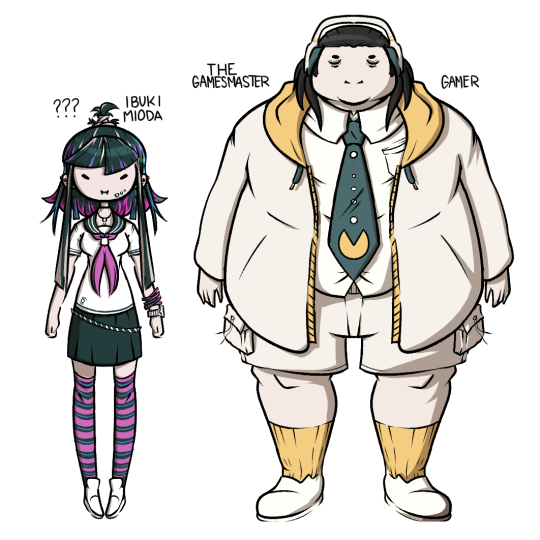
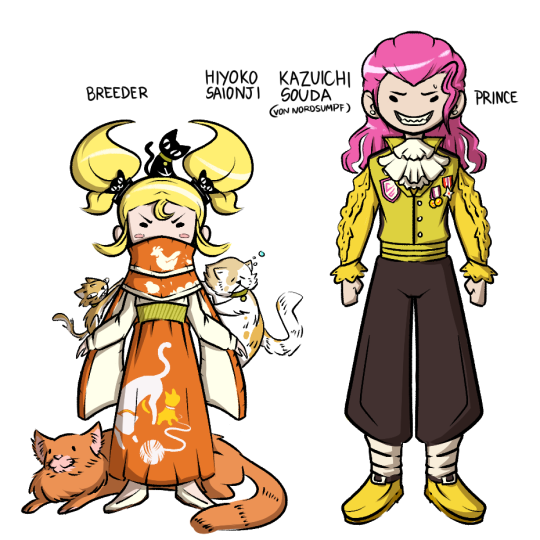

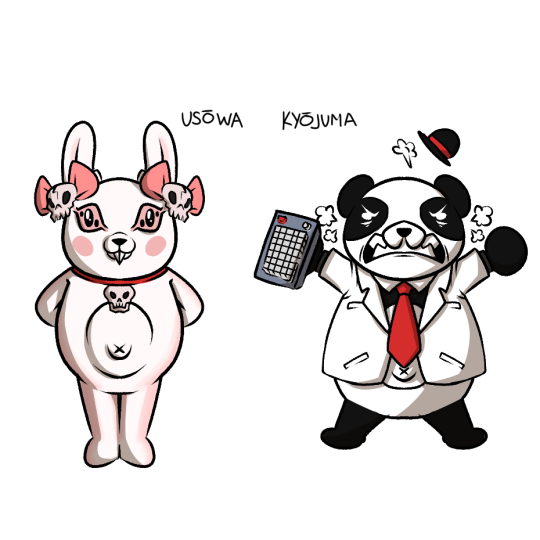
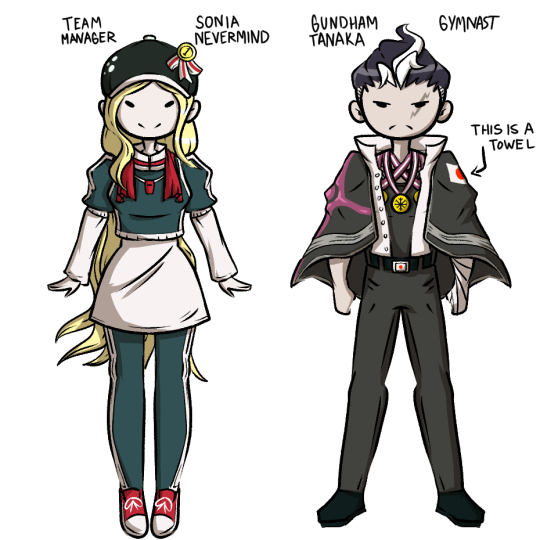

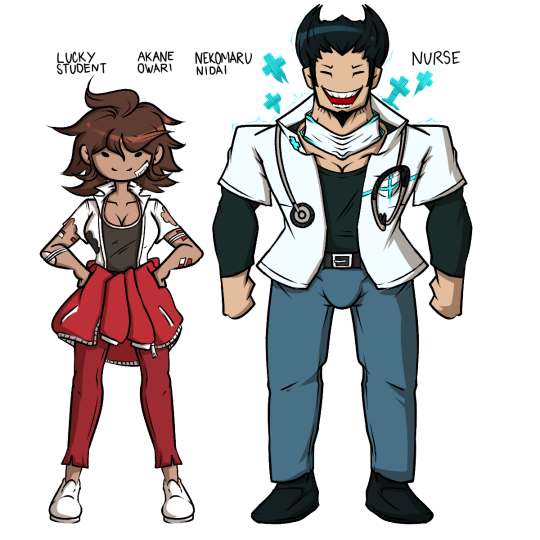

And yeah, all the swaps as you can see above, and these guys in the middle are the replacements for Monokuma and Usami respectively:
Check out under the cut for some design insights on my take AND closer pictures of each pair:
Finally finished my personal AU project. I hope it's to everyone's liking!
I can go on forever about these designs but I'll limit myself to one-two sentences on some facts about the designs.

Mikan: Mikan's face tattoo was commissioned on her against her will so that she can never hide her nature as a Yakuza, but her leg tattoo was done on purpose, and she and Nagito have matching tattoos on their legs, his is just hidden most the time.
Nagito: He is usually seen with a spear and prefers the weapon over the sword, but he is more famous for his natural skill with the blade. That said, he resents the blade and wishes he could be recognized for the things he actually works hard to do, like throwing spears or protecting Mikan and her family.

Ibuki: I kept her design very similar to her base design because she pretty much just looks like a student, and I don't want to change anyone's personality so there's no reason for her to not get highlights. But I gave her some more symmetry in this design and gave her a cute little semi ahoge I guess with a hair tie, bc she doesn't naturally have one.
Imposter/Gamemaster: Yeah I made the big brain choice to keep him with his colors as "Byakuya" because it made for a more striking visual, and more recognizeable as the impostor. Also I made him too tall because I wanted to give him big legs lol.

Hiyoko: Her four cats are named Heart (scraggly cat), Mr. Pearls (sleepy cat), Big Red (Giant cat), and BB (black cat) bc canonically the four dark devas are named after shonen manga, I named her cats after pokemon games, which she canonically likes playing. Also chickens are her favorite animal, despite her love of cats.
Kazuichi: Kazuichi's not a natural born prince, through shenanigans it turns out he's extremely distantly related to some royal line in a microstate north of germany called "Nordsumpf." Their main exports are cars and Kazuichi is still new to being a prince.

"Kyoko": She'd try her best to act like Kyoko, but she's a little too meek and openy affectionate to pull it off properly. Also her knockers are way bigger than Kyoko's, so there's an immediate discrepancy to the trained eye.
Also in my au of DR1, Kyoko is the ultimate affluent progeny and Makoto is author/serial killer.
Hajime: His hair is actually extremely long back there, he just keeps it tied up. On shows he lets it all out and a wears red contacts, his stage name is "Izuru."

Sonia: Sonia became a team manager because she was escaping an assasination attempt, strolled into a junior laegue soccer game, took over for the coach and started just barking orders and the team won. They were the worst team in the whole league and after that she just sorta stuck around them and won them the championships.
Gundham: Gundham was orginally meant to wear the japanese flag… but there was too much white in his design so I cut it. He has names for all of his gymnast moves and he announces them very loudly when he does any of them.

Peko: I tried to give Peko a unique sort of "zombie survivor" kinda vibe so while she's clearly a mechanic first she can also just fucking kill you by braining you with that monkey wrench. Most of the time she's cool though, she's just like horribly dependent on other people to tell her what to do, so she attaches to Kazuichi because he's the most immediately available authority figure.
Fuyuhiko: He's got that sort of machismo that makes him not like to admit he loves dancing, but the moment he's complimented on it he'll really appreciate it. Also he's still part of a crime family, but it's just not as strong as Mikan's.

Akane: She really looks sporty still, but don't worry she's definitely "lucky," she's just much more focused on the future than her bad luck in the moment… which can be very bad, actually, and can make her come across as kind of aloof.
Nekomaru: Why is nurse Nekomaru not as common a thing. Just think about it, it's perfect. Nekomaru here got inspired by the bravery and hard work of the nurses that treated him and boom he became a nurse, nobody tougher than healthcare professionals after all.

Mahiru: Mahiru as a nurse is honestly a really really really fun concept but I feel like I wasn't very ambitious here, and I can't really show it through the drawing but one of my early drafts had her look more like a european chef a la gordon ramsey bc I headcanon her as a scot.
Teruteru: Decided to give him a raincoat which my sister pointed out to me could also be a trenchcoat, which is just PERFECT for a creep like him. It just writes itself man, though seriously he's mostly a landscape photographer who specializes in pics of the countryside. Still a huge perv tho.

Usowa: Name is a combo of Usagi and Chowa, the word for Harmony. She's less like a chaotic force of nature like Monokuma and more a manipulative and hardline teacher who coaxes the students into doing awful things by playing into their insecuritoies with motives, and which then causes them to kill, allowing her to punish them, "weeding out the weak and undisciplined among their ranks." She replaces Monokuma.
Kyojuma: Name is a combo of Kyoju (professor) and Kuma. He's a pretty silly guy with an easy temper to poke at, but he's good at heart and tries his best to be a more sort of "fun" teacher than the rules lawyer Usami kinda was. He just wants to help his students, too bad Usowa showed up and decidedly does NOT like his approach.
#danganronpa#talentswap au#talentswap#danganronpa 2#danganronpa talentswap#fanart#hajime hinata#chiaki nanami#nagito komaeda#mikan tsumiki#hiyoko saionji#kazuichi soda#sonia nevermind#gundham tanaka#peko pekoyama#fuyuhiko kuzuryu#akane owari#nekomaru nidai#teruteru hanamura#mahiru koizumi#komamiki#soudaionji#twobuki#akanidai#fuyupeko#sondham#mani e.#danganronpa demix#monokuma#usami
199 notes
·
View notes
Text

𝑺𝒆𝒕 𝒎𝒆 𝒐𝒏 𝒇𝒊𝒓𝒆, 𝒉𝒐𝒏𝒆𝒚, Camilo Puerta
Original title intact.
Agni. The Symbolism and the Ritual of Fire
Without Fire there is naught. All that is Fire. Its all firework. Fire is the creator, builder and destroyer.
Nakshatra: Krittika, "the one who cuts", is traditionally denoted by a blade or a flame. This picture combines the two motifs, expressing this Nakshatra's sharp, fiery and proactive nature.
The deity ruling Krittika Nakshatra is Lord Agni and mighty Lord Kartikey or Murugan. Agni is the god of fire which is also known as the god having seven tongues. Lord Agni symbolizes wisdom which means that people born under this nakshatra are rich in intellect.
You must get rid of this idea that you are a sinner because it is just an idea that gives you trouble. I don’t say that you are a sinner. I know who you really are. You are me, and you are free. The whole world is affected like this. It is in the blood of each generation, and it goes on indefinitely. But it is all imagination. It is a pile of straw that you can destroy with a single match. But you have been so trained to think about sin and good and evil, you even think that setting fire to this pile of straw might also be a sin. It is all these ideas about good and bad, right and wrong, that stop you from striking the match. Your impediments can all go in a bonfire that is lit by a single match. That fire is freedom. Burn everything with this fire of freedom.
- Papaji
87 notes
·
View notes
Text
⭐️Mini Comic!⭐️
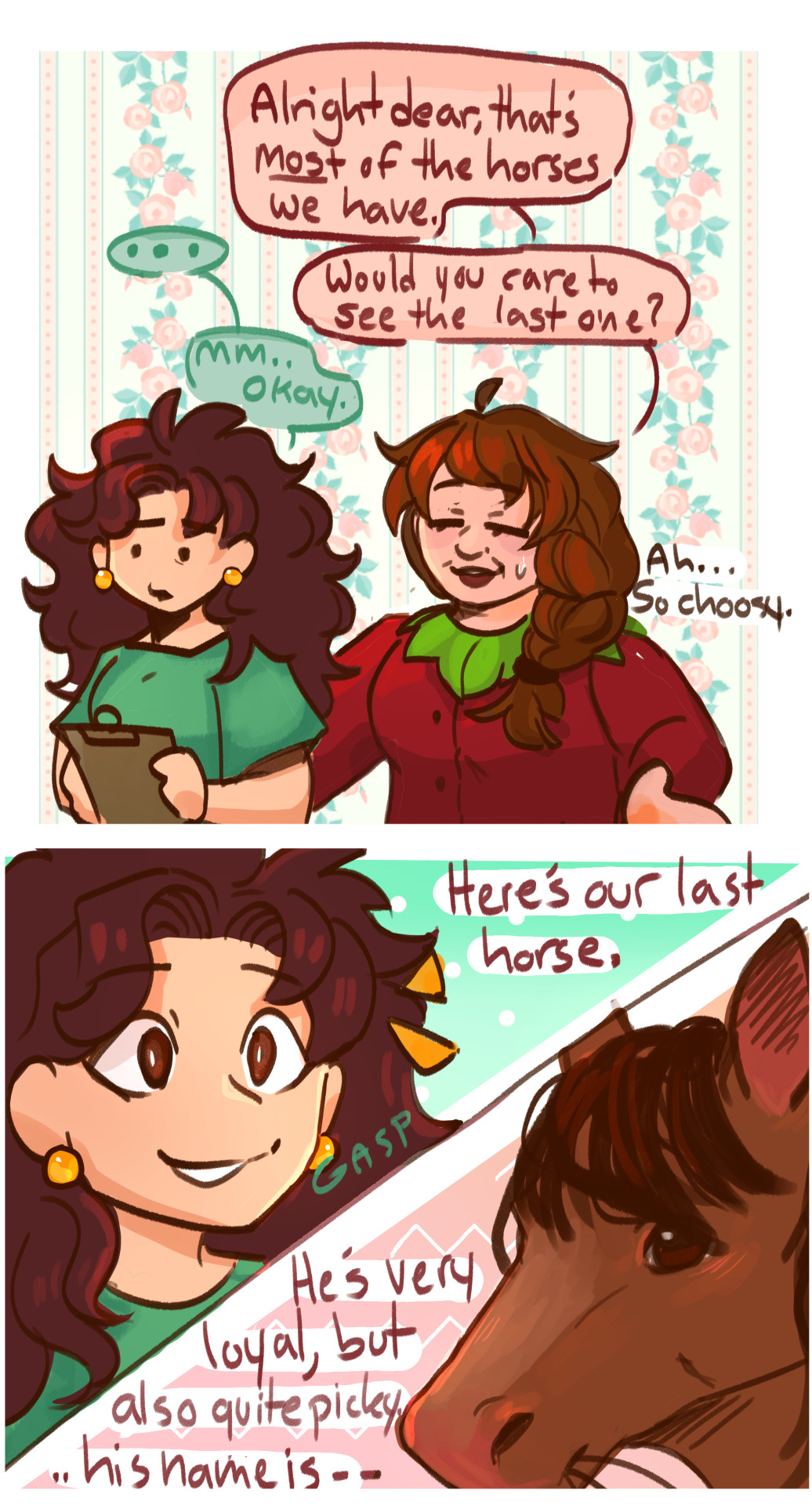
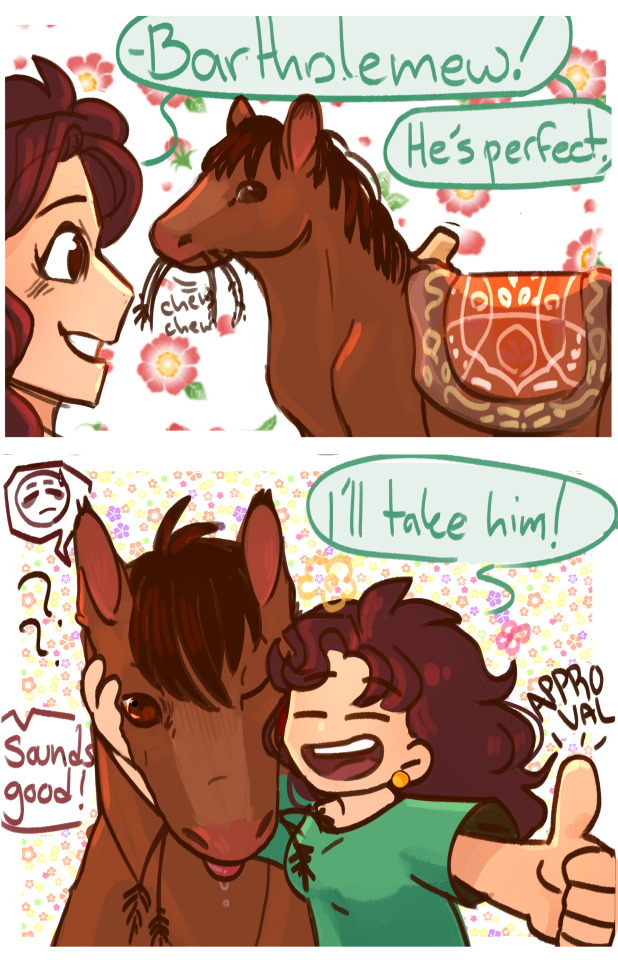
Read the comic here!
I always thought it was a little sad that you couldn't actually pick which horse you would keep, so I like to imagine the farmer gets to choose which one behind the scenes.
This is a little ways in the future, when Deva finally gets a stable! (The only problem is finding a good horse.)
Bonus under the cut!

I think he might need to warm up to you first, Deva.
Temperament aside, at least Bartholomew is better than the other options in Marnie's ranch...

I think I understand why farmers can't pick the horses themselves now.
#stardew valley#sdv#sdv farmer#marnie stardew valley#marnie sdv#stardew farmer#making comics without my tablet... sob#Marnie tries her best with the horses#but even then some of them are off-putting.#horse#horses#farmer deva
149 notes
·
View notes
Text
Y’all 😭 Devasena chopped off Setupathi’s hand herself so Baahubali just beheaded him directly, but cause Varadha didn’t even try to defend himself, Deva ended up cutting off Narang’s hand first and then his head.
80 notes
·
View notes
Text
Deva - The Perfect Salaar
Yes Deva is impulsive and uses his emotions to make most decisions, but he's also extremely smart.
When we see him challenging Rudra's pailwan at the beginning of the movie, he's making a plan to beat him while actively walking into the ring. He sees the wire, finds the tool to cut it, places it exactly where he needs it, and finally pushes the pailwan into doing exactly what he wants. That was not impulsive, it was well thought out and executed.
He is able to kidnap Aadhya from right under the nose of Radha Rama's gang.
Later, we see that he knows exactly how Obulamma is going to trap Aadhya in India. He tells Bilaal that they are going to file a police report on her to prevent her from leaving, and that's exactly what happens.
Every fight he's in, he doesn't win just because of strength. He wins it through his ability to strategize and use his environment and his strength to his full benefit.
In short: Deva is the perfect Salaar - a genius with strength who doesn't use his brain unless given specific instruction.
56 notes
·
View notes
Text
Varadha's Greatest Strength Part 1
A Varadeva fic
Baachi pov for Part 1
warnings: NSFW in Part 2
AU where in the crossfire, Raja Mannar, Radha Rama, Rudra, and the Ghaniyar tribe have perished. Varadha is about to assume the throne when the Shouryangas come to attack.
-
"Anna, they're getting in, we can't stop them!" Baachi cries out, watching the metal doors of the Khansaar inner court warp from the pressure of hundreds of warriors fighting to get inside.
His older brother stands behind him, unmoving. The coolness of his demeanor is irritating Baachi to no end. The Shouryangas were literally on their doorstep and Varadharaja Mannar hadn't even drawn a sword.
"Anna! What do we do!"
Finally, his brother looks at Baachi, and his lips twitch into the slightest smile.
"We can't beat them, don't bother. Let them come in."
At this, even Varadha's loyalists gape at him, but before they can say anything, the doors smash open.
With a cheer, the Shouryangas make their way into the room, quickly surrounding the few men left willing to fight for the last lord of the Mannarsi.
"Anyone lay a hand on my brother and I'll-" Baachi is cut off by Baba's hand on the arm holding up his rifle. He looks at Baba, who just shakes his head and gestures at a familiar figure walking towards them.
"You!" Baachi exclaims. "After all my brother did for you, after bringing you here, you dare betray him?"
Devaratha doesn't even look at Baachi as he passes by, who realizes in horror that Devaratha is going straight for his older brother, standing in front of the Khansaar throne.
The Shouryanga army and Varadha's loyalists both hold their breaths, waiting to see what would happen.
Devaratha reaches Varadha, who still has that damned smile on his face.
Please let it be honorable and quick, Baachi prays. It was bad enough that the person his brother loved the most would be the one to end him.
To everyone's surprise, instead of striking Varadha down with his sword and claiming the throne, as was Devaratha's birthright, Baachi sees Devaratha kneel.
It's a slow, deliberate action, meant to dispel any confusion over its purpose. Devaratha keeps eye contact with his brother until he fully reaches the ground, and then drops into a low bow.
"I, Devaratha Raisan," the man starts in his gravelly voice. "Pledge allegiance to Varadharaja Mannar of the Mannarsi tribe."
Gasps are heard around the room, and the Shouryanga leaders, Bharava and Dheru, look furious. Baachi himself isn't sure what's happening.
"I have vowed to protect my Sulthan, and I will always be his Salaar. Anyone who disagrees will cross Dhaara Raisan's son."
Baachi sees his brother's smile widen into something more joyful, something softer and more intimate than he thinks a roomful of enemy Shouryanga warriors should be seeing. And in the second twist of the night, Varadharaja Mannar moves forward to kneel before Devaratha.
He gently caresses Devaratha's face, who leans into the touch as if he craves it.
"My Salaar," Varadha says, so softly Baachi almost can't hear it over the sound of the unhappy Shouryangas. He can't see what expression Devaratha makes at that, but it's enough for Varadha to grip him by the jaw and pull him in for a kiss.
Oh. Ohhhhh.
"Deva, what-" Bhaarava tries to yell but is interrupted by Devaratha, who stands up and raises his sword.
"I WILL NOT LET ANYONE TOUCH HIM!"
The declarations stuns the Shouryangas, who, after a long pause, start to back away.
The reality of the situation sets in for Baachi, and he can see from the suddenly hopeful faces that Baba, Bilal, Rinda, and the others have also understood.
Devaratha was never a threat, never a weakness, he had always been Varadha's greatest strength.
Baachi's face breaks out into a grin. "All hail the next karta of Khansaar, Varadharaja Mannar!"
"No, Baachi." His brother says, standing up. He locks eyes with Devaratha once more. "There will be a change to the Nibandhanam."
Varadha turns to address the entire room. "Shouryangas!" He calls.
The retreating army pauses. Bhaarava glares at Baachi's brother. "What do you want?"
Varadha just smiles at him, and grasps Devaratha's hand. "I propose an equal partnership between the Mannars and the Shouryangas."
Dheru scoffs, and Bhaarava narrows his eyes. "And how will you do that? When the rightful heir to the throne and the savior of our tribe is beneath you?"
Varadha shakes his head. "Deva is not beneath me. My Deva is always an equal to me, the one I love most."
Devaratha gives him the sappiest look Baachi has seen a man give another person, and he internally shudders.
Ugh. That man was going to be his brother-in-law soon at this rate.
"Which is why I want to rule Khansaar with Deva. As a partnership."
There it was.
Bhaarava gives Devaratha a cautious look, who nods.
"And what will that entail for us?"
Baachi tunes out once the negotiations start, but he's glad that his brother is alive and happy once more, even if it means he has to keep dealing with Devaratha.
He catches Varadha's eyes during a break, and sees the question in them: Are you okay with this? With him as well?
Baachi smiles in response, and sees Varadha relax at the confirmation that Baachi approves.
-
tagging moots and the people that commented on my post about writing a smut fic: @deadloverscity @sada-siva-sanyaasi @sambaridli @sometimesbrave @just-a-lazy-person @vijayasena @mad-who-ra @umbrulla @jitterbugbetty @importantpiratesgetscaredofme @chocolate-1-0-1 @pitrsattabhaadmeinjao @sinistergooseberries @tulodiscord @varadevaficrecs
#salaar#salaar fic#varadeva#yes genocide is bad and the shouryangas deserve the throne but consider: i need varadha to be happy#ending is lowkey rushed i know#part 2 in progress
88 notes
·
View notes
Text
One thing I haven’t seen talked about as much as I would’ve thought is Devas heart stopping for a bit after the wire.
youtube
Tried to screenshot but Netflix doesn’t like that apparently but I found the clip on YouTube. The way the audio builds tension with that whirring noise until Varadha hits his chest then there’s the heartbeat and a sort of exhale sound.
He literally stopped his heart for Varadha and it was varadha that got it going again. Everything is even blurry except Varadha in most of that scene from Devarathas perspective
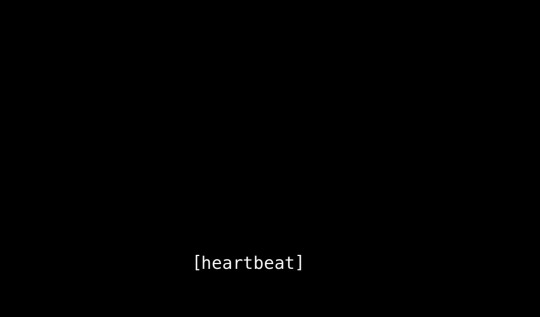
Also I fully believe he knew dying was a possibility he was old enough to be left seemingly with no of minimal supervision in some sort of metalwork/mechanics shop.
It took him barely any time to think of and implement his wire plan and he knew how to cut the wire without shocking himself to soon.
50 notes
·
View notes
Text
Demon king, demigod, drunkard, dōji: exploring the archetypal oni, from Ōeyama to Lotus Eaters
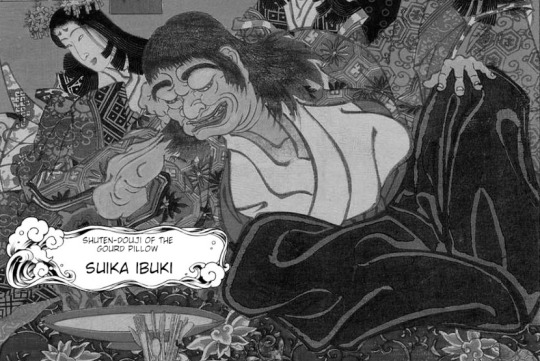
By popular demand, I wrote an article covering the background of Shuten Dōji and his underlings, and how it influenced Suika’s character and the idea of the Four Devas of the Mountain in Touhou. It was initially scheduled for last month, but I’ve experienced unplanned delays.
Read on to learn if you want to learn what Suika has to do with Yamata no Orochi and Mara, if it’s true that oni never lie, and more. I will also explain why making your own fourth Deva of the Mountain is entirely fair game and anyone telling you otherwise is wrong about the source material which inspired ZUN.
The article contains some spoilers for WaHH and a number of other Touhou installments, so proceed with caution if that might be an issue for you.
Ōeyama, or Shuten Dōji: origins
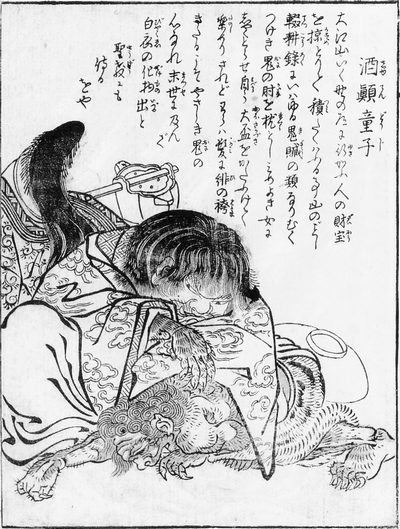
Shuten Dōji, as depicted by Sekien Toriyama in Konjaku Gazu Zoku Hyakki (wikimedia commons)
It perhaps seems a bit silly to start this article with an inquiry into the identity of Shuten Dōji (酒呑童子, “wine-loving youth” or something along these lines). After all, while Touhou characters are often based on obscure figures, Suika is hardly an example of that category. Shuten Dōji is arguably THE archetypal oni, known even to people with limited familiarity with Japanese mythology and folklore. And yet, the matter is nowhere near as clear cut as it might seem at first glance. From a certain point of view, Shuten Dōji might not even exactly be an oni, strictly speaking.
A book from Nara simply titled Ōeyama ("Mt. Ōe") offers a detailed account of Shuten Dōji’s origin. His father was not a man or a demon, but rather a mountain god, Ibuki Daimyōjin (伊吹大明神). That’s not all, though - according to a local belief, Ibuki Daimyōjin was actually Yamata no Orochi. How does that even work? Contrary to the more widespread tradition, the inhabitants of the area around Mt. Ibuki from the Muromachi period onward believed that Orochi survived his confrontation with Susanoo and hid in the mountains.
That’s actually not even the most unusual variant tradition about Orochi. A widespread belief through the middle ages was that he eventually managed to redeem himself, becoming a divine dragon (shinryū, 神龍) residing in the dragon palace under the sea. In that capacity, he was sometimes associated with emperor Antoku, with the latter even claimed to be his reincarnation, for example in a local legend associated with the Atsuta Shrine, preserved in the noh play Kusanagi. In esoteric Buddhist doctrine Orochi was sometimes perceived as a local manifestation (suijaku) of the buddha Yakushi - much like Susanoo was.
Ichijō Kaneyoshi in his Nihon shoki sanso (1455–1457) went into yet another direction, presenting the snake as identical with the naga girl from the Lotus Sutra. Apparently, he specifically means the version of her from Shaku Nihongi… who is identified there as Susanoo’s wife, down to being equated with Kushinadahime (this was not unusual in itself - Susanoo was equated with Gozu Tennō based on similar character, so it was sensible for their wives to be seen as analogous). This effectively created a scenario where Susanoo married his nemesis.

A Japanese depiction of the naga girl offering a jewel to the Buddha, as described in the Lotus Sutra (wikimedia commons)
Anyway, back to Shuten Dōji. According to Ōeyama, Ibuki Daimyōjin, before he even came to be known under this name, fell in love with the daughter of a local feudal lord, Sugawa. He started visiting her at night and she as a result eventually became pregnant. The identity of the visitor was unknown to her father, and out of frustration and fear that nefarious supernatural forces might be involved he eventually contacted various religious officials to perform exorcisms. Needless to say, Ibuki Daimyōjin was less than thrilled, and decided to display his divine wrath through rather conventional means: Sugawa was struck by illness. He once again summoned various Buddhist monks and onmyoji, this time to attempt to heal him. They concluded that the disease will disappear if the deity who caused it is properly honored, and established formal worship of Ibuki Daimyōjin, which apparently did indeed help.
Sugawa’s daughter eventually gave birth to Ibuki Daimyōjin’s child. The child started to cause problems at the age of three: his love of alcohol manifested for the first time, earning him the moniker of Shuten Dōji. By the time he was ten, his misdeeds were too much for his family to bear with and his grandfather decided to send him to Mt. Hiei to become a novice (chigo). The monastic lifestyle didn’t really change much though, and Shuten Dōji continued to drink. Eventually he managed to convince three thousand monks (sic) to drink with him and to join him in an “oni dance” during which everyone put on masks representing demons. The festivities lasted seven days. When Shuten Dōji woke up afterwards, he realized his mask had fused with his face, and he was no longer able to take it off. The other participants fled out of fear of his new form.
Shuten Dōji’s Mt. Hiei career was subsequently cut short by Saichō, the founder of the Tendai school of Buddhism. After learning what happened, he prayed to the buddha Yakushi and to Mt. Hiei’s protective deity Sannō Gongen to banish Shuten Dōji. It's worth pointing out that presenting young Shuten Dōji and Saichō as contemporaries is basically standard, and pops up in multiple legends. There are variants where Kūkai, the founder of Shingon, plays a similar role instead, to. They actually lived some 200 years before the other historical figures who appear in Shuten Dōji narratives, but this is not an oversight. It is a given that a partially divine being would live for much longer than a human.
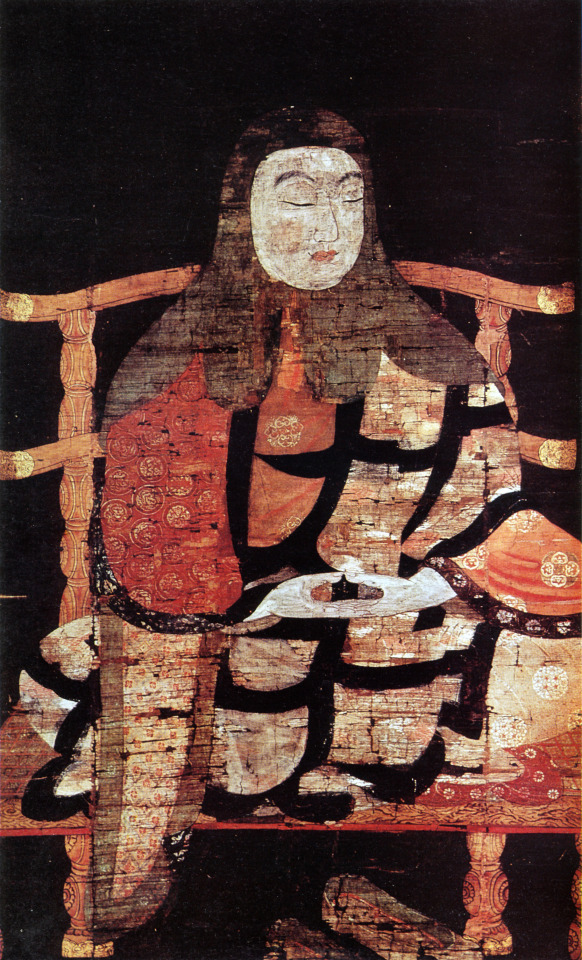
A Heian period portrait of Saichō (wikimedia commons)
As a result of Saichō’s success, Shuten Dōji had to flee. He tried to return to his grandfather’s residence, but this was no longer an option for him. He temporarily hid on Mt. Ibuki, but eventually left for Mt. Ōe, where he finally became a veritable "demon king".
The reason why Shuten Dōji was rejected by his family is that he was recognized as an “oni child” (鬼子, onigo). In the folkloric sense, this term refers to supernatural beings which are nonetheless partially human by birth. Not necessarily part oni, though. Another well known onigo, Sakata no Kintoki, was the son of a yamauba, for instance.
However, Yanagita Kunio noted that this term also referred to children born with teeth (a real, though very uncommon phenomenon), who were believed to turn into oni - much like how Shuten Dōji did. He states that especially before the Edo period this lead to cases of child abuse or outright murder. In some cases sending the child to become a member of Buddhist clergy was seen as a remedy. For example, a twelfth century monk named Jōjin in a letter relays that he suggested this to the mother of such a newborn. It is not hard to see that Ōeyama likely consciously references this custom.
The other origin of Shuten Dōji
Yet another tradition is preserved in a variant of the standard Shuten Dōji tale which switches the location of his demise from Mt. Ōe to Mt. Ibuki: here Shuten Dōji is not just any demon, but a manifestation of Mara. As in, the opponent of the Buddha and demon king of the sixth heaven, not some other accidentally similarly named figure.
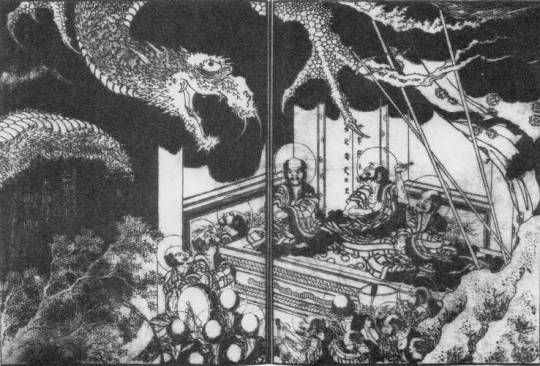
Mara, as depicted by Hokusai in Shaka-goichidai-zue (wikimedia commons)
It is presumed that this portrayal of Shuten Dōji might be tied to medieval Japanese traditions pertaining to Mara. They might sound unusual today: he was both a “demon king” (魔王) obstructing enlightenment, as expected, but also a jinushi (地主), or “landholder deity”. From the Buddhist point of view, jinushi were ambivalent figures: on one hand, their presence was responsible for bestowing specific locations with holiness. On the other hand, they could resist Buddhism as demonic forces, and had to be subjugated or converted to prevent that. Mara was the ultimate jinushi, the king of the world as a whole. A role already attributed to him in earlier Buddhist sources was basically adjusted for this framework.
The jinushi version of Mara originated among proponents of the imperial court and mainstream Buddhist institutions, but it curiously also gained traction among the opponents of these structures. Mara became somewhat of an anti-establishment icon more than once, essentially. A legend links him with (in)famous rebel Taira no Masakado (who you may know from SMT) for this reason.
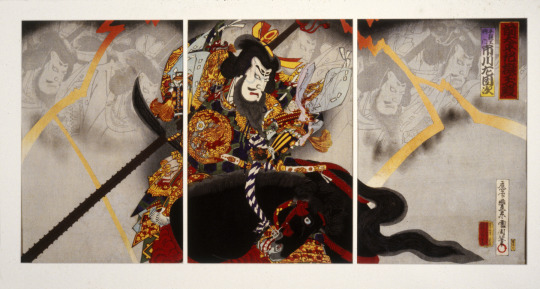
Masakado, as depicted by Kunichika Toyohara in Sen Taiheiki Gigokuden (wikimedia commons)
Other similar examples are also known. A local legendary figure from the Tsugaru peninsula in modern Aomori prefecture, Tsugaru Andō (津軽安藤), who after a failed rebellion fled to Hokkaido, was proudly described as a vassal of Mara by local officials who claimed descent from him. Prince Sutoku, a banished opponent of emperor Go-Shirakawa, swore a vow to become like Mara. Oda Nobunaga famously referring to himself as the “demon king of the sixth heaven” in a letter to Takeda Shingen is likely another example.
Reportedly a related belief that praying to the jinushi version of Mara can spare one from conscription persisted as late as the early 20th century, though generally he belongs to the realm of “medieval myths” which faded with the ascent of a new system of values in the Meiji period, in which the early imperial chronicles were favored. Even though it is largely forgotten today outside of specialized scholarship, there is much more to this Mara tradition. It led to the development of one of my favorite Japanese myths with no popcultural reception, but you will have no wait a few more weeks to learn more.
It has been argued that behind the identification of Shuten Dōji and Mara might reflect a historical event of the sort which led to associating the latter with figures such as Masakado. In other words, that Shuten Dōji in this case might be less a demon and more a demonized form of some opponent of imperial or religious authorities.
It has been argued that the Ibuki version was the result of combining an original oral narrative, a precursor of the textual versions we are familiar with today, with the memory of the death of a certain Kashiwabara Yasaburō, a bandit leader, in 1201. It has in fact been argued that even the mt. Ōe version might simply be a particularly fabulous reinterpretation of a punitive mission against bandits robbing and murdering travelers. Such rationalist explanations are not exactly new - Ekken Kaibara already argued in the Edo period that the legend of Shuten Dōji must have been the reflection of the downfall of a real bandit who perhaps wore the mask of an oni while committing robberies.
It’s important to bear in mind to not go overboard with this speculation, though. Ultimately the Mt. Ibuki version has a more pronounced religious character than other variants in general: Shuten Dōji’s nemesis Raikō’s is identified as a manifestation Bishamonten or Daiitoku Myōō (in the latter case, Bishamonten and the three other heavenly kings correspond to his four retainers), emperor Ichijō with Miroku (Maitreya), and Abe no Seimei, who plays a minor role in vanquishing the demon, with Kannon.
These equations reflect the idea of honji, or “true nature” of Buddhist figures, who were believed to take various guises through history to help people reach nirvana, for example these of local deities or historical figures. The best known example of application of this doctrine in Japanese Buddhism is obviously the historical phenomenon of honji suijaku, which was focused specifically on kami.
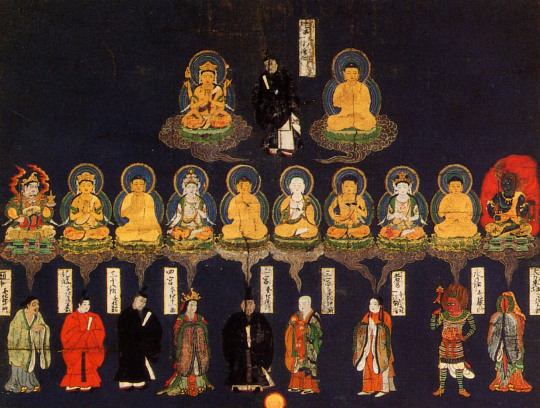
A Kasuga mandala representing the correspondences between Buddhist figures and local kami (source; reproduced here for educational purposes only)
The legend of Shuten Dōji
Regardless of which mountain is identified as the residence of oni, and of whether the dramatis personae are identified with Buddhist figures or not, the plot of the various versions of the legend of Shuten Dōji surprisingly does not vary all that much. While it is reasonably well known, I figured it won’t hurt to summarize it here anyway, especially since the information above should make it possible to view it from many new angles.
The oldest surviving version, Ōeyama Ekotoba (“Illustrations and Writing of Mt. Ōe”), presumably based on preexisting oral sources, comes from the fourteenth century, specifically from the Nanbokuchō period. However, the story only reached the peak of its popularity a few centuries later, in the Edo period. This was a part of a broader phenomenon: preexisting tales about warriors matched the sensibilities of the new ruling classes and were kept in circulation by them, but eventually they also became a part of urban popular culture. Many adaptations were produced, including noh plays and ukiyo-e. To put it very colloquially, the heroic warriors and demon quellers from the previous periods became the Edo period counterpart of contemporary superhero media. This is a genuine comparison employed in scholars, for clarity, not a joke.
As remarked by Bernard Faure, the most widespread version is basically framed as if it was a tabloid story from the Heian period. In 995, young women (and in some versions men too) disappear whenever a particularly violent storm occurs, and nobody knows how to stop it. Not even the power of Buddhist exorcisms is enough. Seeing as in the portrayed time period that was pretty much the universal solution to supernatural problems, this is a big deal.

Abe no Seimei (right) in the Fudo Rieki Engi (wikimedia commons)
This is a source of distress for a certain official, Ikeda Kunikata (or, in some version, Kunitaka), whose only daughter is among the kidnapped women. He decides to seek the help of the Heian period superstar Abe no Seimei, arguably the most famous onmyoji in history. Alternatively, the expert contacted is a certain Muraoka no Masatoki, who to my best knowledge is a fictional character and doesn’t appear anywhere outside of some variants of this tale.
Either way, thanks to this intervention it is possible to identify the culprit as a demonic being residing on Mt. Ōe (or alternatively on Mt. Ibuki). In one of the versions featuring Seimei he specifically identifies him as a tenma (天魔), “heavenly demon” - a term commonly used to refer to tengu (as ZUN does in Touhou) and to servants of Mara (overlapping if not identical categories, really; stay tuned for a future article exploring this).
However, onmyoji arts are not enough to stop the crisis; all Seimei can guarantee is that Kunikata’s daughter will survive, but he has no way to confront the demon directly. Kunikata therefore decides to bring the case to the attention of the emperor, Ichijō. He holds a meeting with various ministers, who note that in the past a similar case was solved by Kūkai (recall his already mentioned association with Shuten Dōji). However, there are no monks of equal skill left, so his feat cannot be repeated.
It is then concluded that the only way to end the demon’s reign of terror it is to send the strongest warrior they were aware of, Minamoto no Yorimitsu (Raikō) and his four retainers, Watanabe no Tsuna, Sakata no Kintoki, Taira no Suetake, and Tairi no Sadamitsu, on a mission to kill him. Raikō is also assisted by Fujiwara no Yasumasa (Hōshō) and his anonymous attendant, but these two never gained much prominence as characters in this narrative. Additionally, in some versions other figures from the same period - Taira no Muneyori, Minamoto no Yorinobu (Raikō’s younger brother) and Taira no Korehira - are namedropped as potential candidates considered by the emperor, but they all reportedly decline to partake out of fear.

Raikō and Kintoki, as depicted by Yoshitoshi Tsukioka (wikimedia commons)
Preparations started with prayers in Sumiyoshi, Kumano, Kasuga and, in some versions, Hie shrines. They did not go unanswered. Raikō and his retainers subsequently encounter a group of shugenja (mountain ascetics) who turn out to be the manifestations of the deities they paid honor to: Sumiyoshi Myōjin, Kumano Nachi Gongen, Hachiman (here addressed as a bodhisattva) and, if the Hie shrine is included in a given version, Sannō Gongen. They explained that to safely enter the fortress of Shuten Dōji, Raikō and his men must disguise themselves as shugenja (that’s because the legendary first shugenja, En no Gyōja, famously had an entourage of demons). They also provide him with supernatural wine. They state the oni will inevitably drink it due to their fondness of alcohol, only to end up poisoned as a result. In some versions they vanish afterwards, but in others they continue to accompany Raikō.
The protagonists then encounter a woman washing blood stained clothes. In some versions she is described as elderly, and states she has lived for 200 years as a servant of Shuten Dōji. In the most widespread Edo period version, she is young and says she was only kidnapped a year earlier, though.
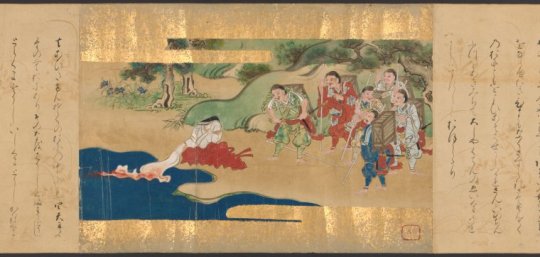
Encounter with the woman washing bloody clothes (NYPL Digital Collections)
Regardless of her age, she reveals some additional information about Shuten Dōji, though that also varies depending on the version. In some, she explains that he looks like a human during the day, but takes the form of an oni at night. His human form is specifically that of a dōji, literally “child”, but we’ll get back to the full context of this term later. In any case, I think it's safe to say the shape and size changing is where Suika'a ability came from.
In another variant, the woman warns the heroes that Shuten Dōji is enraged by Abe no Seimei’s actions, as the onymoji apparently figured out in the meanwhile how to keep the people of Kyoto safe by employing a number of shikigami (a standard part of his repertoire).
There are no further stops on the journey, and shortly after the encounter with the woman of variable age Raikō and his men enter the mountainous land of the oni. Especially in the older versions, it’s a place completely out of this world, with all four seasons occurring at once. Once they enter the fortress located there, they instantly encounter Shuten Dōji… and ask him for a place to stay for the night.

Distinctly human-like Shuten Dōji, as depicted by Yoshitoshi Tsukioka in One Hundred Ghost Stories from China and Japan (LACMA; reproduced here for educational purposes only)
Rather unexpectedly, he instantly agrees. He then tells them about his past; this largely a shorter version of the legend already discussed earlier, though with nothing predating the Mt. Hiei section mentioned. We also get a specific date for his arrival on Mt. Ōe, 849. This doesn’t last long, though, and soon he invites the protagonists to partake in a feast with him. This is obviously not a regular party, and while the individual versions can be more or less graphic, it is clear that the oni are consuing the flesh and blood of their captives.
Despite various horrific sights, Raikō maintains composure. He uses the opportunity the feast presents him with to offer Shuten Dōji the sake he received from the three (or four) deities earlier. As expected, Shuten Dōji gets drunk, and leaves to rest in his chamber.
The other oni continue to party. In some versions, some of them try to approach the protagonists by disguising themselves either as a group of courtly ladies or as a dengaku troupe, but Raikō’s glare is so intense they quickly relent. Eventually all of the oni give up on attempting to engage with the alleged ascetics and end up drunk.
That’s when the heroes decide to free their captives. These obviously include the women from Kyoto. However, as it turns out, Shuten Dōji’s rampages actually extended beyond Japan, to India and China, though only captives from the latter area actually appear. Multiple versions additionally mention that one of the prisoners was a young acolyte of the Tendai abbot Ryōgen, who was protected by assorted deities. This doesn’t really come into play in any meaningful way, though. Once everyone is freed, the heroes draw their weapons and enter Shuten Dōji’s chamber.
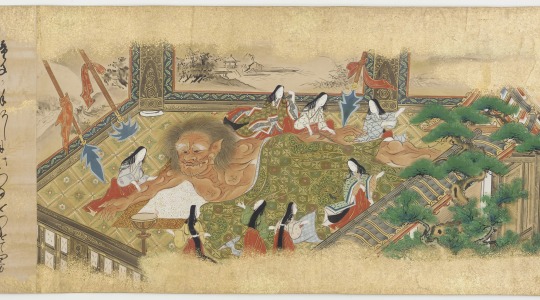
Sleeping Shuten Dōji (National Museum of Asian Art; reproduced here for educational purposes only)
The protagonists finally witness Shuten Dōji's oni form. He is five jō (around fifteen meters) tall, has fifteen eyes and five horns. His head and torso are red, his right arm is yellow, his left arm is blue, his right leg is white and his left leg is black. This might be a reference to the five elements. Alternatively, he could be described as entirely red, which might either be yet another way to reference his love of alcohol, as in the case of the shōjō, or an indication he was comparable to a “plague deity” (疫神, ekijin).
The manifestations of the deities from earlier show up again, this time to hold Shuten Dōji in place so that Raikō can strike. He cuts off his head, but to his shock it rises into the air and starts talking.

Confrontation between the heroes and the floating head of , as depicted by Yoshitsuya Utagawa (wikimedia commons)
Shuten Dōji actually mocks the heroes: “How sad, you priests! You said you do not lie. There is nothing false in the words of demons.” Needless to say, his final words are pretty directly referenced in Touhou. Oni, at the very least, claim they do not lie. Mileage of course varies, though.
ZUN is not the only author drawn to this element of the legend. It would appear that even the Japan Oni Cultural Museum has advertised itself with the words “there is nothing false in the words of demons” in the past. As noted by Noriko T. Reider, emphasizing this apparent honesty (or naivete) sometimes serves as a way to make oni sympathetic or even relatable for modern audiences.
However, it's worth noting that in the noh version, Raikō pushes back against Shuten Dōji’s words, and points out even the claim oni do not lie is a lie. He has a point, considering some versions outright establish oni capture their victims by disguising themselves as people close to them, imitating their voices. It probably also should be pointed out that in Konjaku Monogatari, oni are said to be scary precisely because they can tell apart right and wrong.
Anyway, oni ethics aside, it turns out that to kill Shuten Dōji for good, one has to gouge out his eyes. Once that is accomplished, Raikō's mission is finally complete. After killing the other oni, the protagonists take the head with them to Kyoto. Obviously, they also take the freed captives with them. The young women return to their families, and the Chinese men head for the coast to find a ship which could take them home. They promise to let the emperor (the Chinese one, for clarity; that would be Zhenzong of Song in 995) about Raikō's heroism.
In the versions where the woman washing clothes was elderly, rather than simply one of the young captives, on the way back the protagonists learn that she has passed away in the meanwhile, since her lifespan was unnaturally extended by Shuten Dōji. Once he died, so did she.
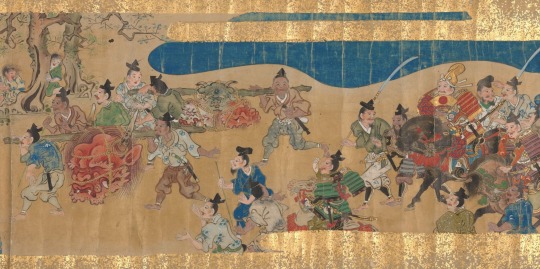
Transport of Shuten Dōji's head to Kyoto (NYPL Digital Collections)
Before the head can enter the capital, a purification ritual has been performed. Abe no Seimei thankfully knows how to do that. Thanks to him, all the relevant authorities can examine it. The emperor decides it will be best to store it in the treasure house of Uji. This location pops up in multiple legends. The severed heads of the two other equally famous malign entities, Ōtakemaru and Tamamo no Mae, were also stored there according to legends focused on them, in addition to various Buddhist relics and mundane treasures.
In an alternate version, the head never reaches the imperial court. Raikō and his retainers encounter the bodhisattva Jizou, who tells them it is too impure to be shown to the emperor, and suggests burying it. The location selected, a hill on the northwestern limits of the city, came to be known as Kubizuka (首塚), literally “head tumulus”. Shuten Dōji actually came to be enshrined there as Kubizuka Daimyōjin (首塚大明神), and in this divine guise developed an association with learning and ailments of the head.

The Kubizuka shrine in 2019 (wikimedia commons)
There is yet another variant tradition about the final fate of Shuten Dōji: after his death he became a vengeful spirit, and then turned into a tsuchigumo, just to be defeated by Raikō and his retainer Tsuna for a second time.

Raikō and Tsuna battling tsuchigumo, as depicted in Tsuchigumo no Sōshi Emaki (wikimedia commons)
Interestingly, it has been argued the tale of Shuten Dōji was at least in part based on that of the tsuchigumo Kugamimi no Mikasa (陸耳御笠), who resided on Mt. Ōe according to Tango Fudoki Zanketsu (丹後風土記残欠). The tale is not preserved fully, though, so all we know for sure other than the location is that the hero opposing him was Hikoimasu no Miko (日子坐王), a stepbrother of emperor Sujin (he is also attested in other sources). A second tsuchigumo, Hikime (匹女) is successfully defeated, but the fate of Mikasa is left unspecified in the surviving sections. This obviously makes further comparisons difficult. The topic of tsuchigumo cannot be dealt with here due to space constraints, but I promise I will return to it in a future article.
The supporting cast of Shuten Dōji
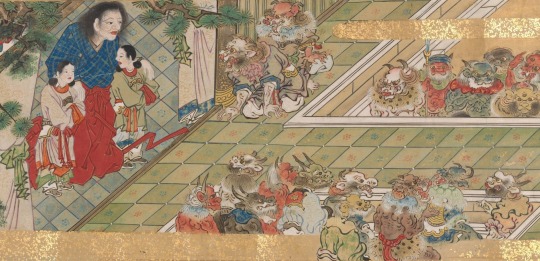
Shuten Dōji in his human form and his oni henchmen (NYPL Digital Collections)
Something that requires further discussion is the matter of the underlings of Shuten Dōji, since it is a topic directly relevant to Touhou. You might have noticed I actually avoided referencing them in any meaningful capacity in the summary of the legend. That’s because they actually do not play a major role. There also wasn’t any consistent view regarding their number or names. However, the version which came to be standard in the Edo period lists four of them - an obvious mirror of Raikō and his entourage. As a matter of fact, both groups even share the same moniker, Four Heavenly Kings.
This idea predates the Edo period, though. An earlier variant based on picture scrolls created by Kanō Motonobu already lists four servants of Shuten Dōji: Gogō, Kiriō, Ahō, and Rasetsu (yes, an oni named Rakshasa). However, two additional oni at his service are also listed, Kanakuma Dōji and Ishikuma Dōji. They are described as his personal guards, and as, well, dōji. It is clear the term is used in a literal sense here - they are said to look like “overgrown adolescents”. Two different subordinates are mentioned in another picture scroll: Kirinmugoku (麒麟無極) and Jakengokudai (邪見極大). However, they do not receive any characterization, or even physically appear in the narrative. Shuten Dōji shouts their names when he is about to die, and the very assumption that he’s referring to his oni subordinates is conjectural. The same version states that there were at least ten oni in the fortress so it’s not like it’s an implausible assumption.
The group of four oni returns in the standard Edo period version, where their names are Hoshikuma (“Star-bear”) Dōji, Kuma (“Bear”) Dōji, Torakuma (“Tiger-bear”) Dōji and Kane (“Iron”) Dōji. There’s also a fifth oni who is not a member of the group of 4, but shares the same naming pattern, Ishikuma Dōji. He actually gets a handful of lines, though they do not really provide him with much of a character beyond establishing he likes sake, that he eats humans, and that he is loyal to Shuten Dōji. Kane Dōji also gets a single line… explicitly alongside Ishikuma and multiple other nameless oni, though, and it boils down to announcing they will go down fighting because without their leader they no longer have a place to go.
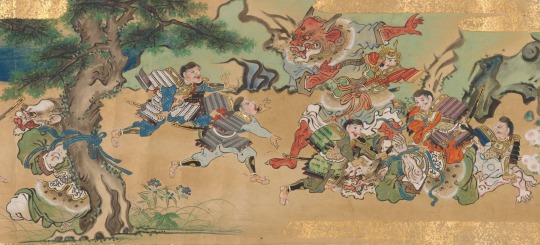
Defeat of the oni (NYPL Digital Collections)
Ibaraki Dōji: Shuten Dōji’s only equal?
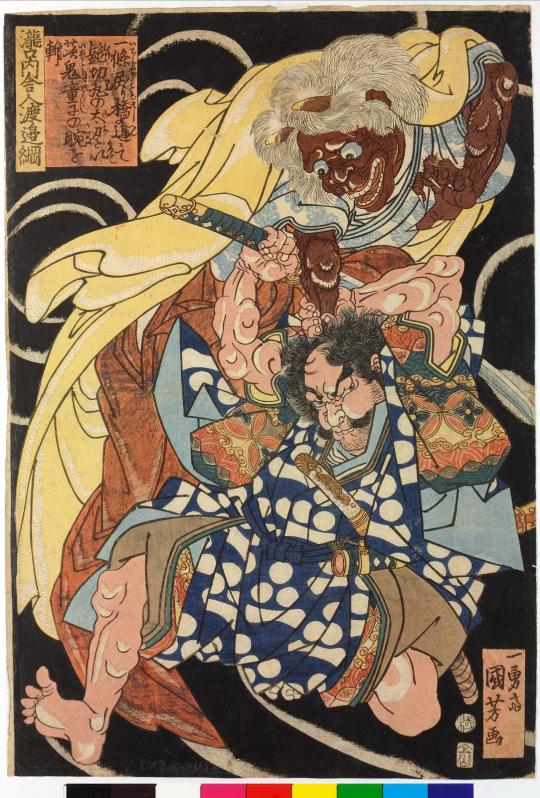
Watanabe no Tsuna battling Ibaraki Dōji (wikimedia commons)
A further unique case is that of Ibaraki Dōji, who actually acquired some fame as an individual character, and today is sometimes cited as an example of an oni equally archetypal as Shuten Dōji.
Despite being portrayed as a close associate of Shuten Dōji, Ibaraki Dōji to my best knowledge isn’t counted among the Four Heavenly Kings in any version. The character of the connection is evidently more nebulous. I know an assertion that a tradition presenting Ibaraki Dōji as Shuten Dōji’s wife is attested is repeated as fact on wikipedia and various at least semi-credible websites, but there is never a citation provided, and no version of the narrative covered in articles and monographs I have access to includes such an element. I am not claiming it is impossible, though I do feel the fact it doesn’t come up in any paper or monograph discussing either figure I have access to doesn’t mention to might indicate it’s either a recent reinterpretation or a very obscure local variant. Note this is not meant to be an argument against any Touhou ships.
What I can say with certainty is that Ibaraki Dōji’s gender is actually a matter of occasional academic dispute. In the versions of the basic Shuten Dōji narrative which mention this oni, he is pretty firmly male. However, he is said to be capable of taking the form of a woman. Noriko T. Reider argues that on this basis it can be effectively assumed that at the very least this specific oni can be considered genderless or capable of freely changing their gender, though she tentatively extrapolates this ability to oni in general.
While Ibaraki Dōji’s gender changing adventure is technically its own legend, a reference to it was incorporated into the basic Edo period version of the Shuten Dōji narrative. During the feast, the latter mentions in passing that the former, his trusted ally, lost his arm in a fight with Watanabe no Tsuna during one of their Kyoto raids, after failing to abduct him while disguised as a woman. He clarifies that the arm was later recovered, but not particularly many details are provided.
The rivalry between Tsuna and Ibaraki Dōji subsequently comes into play after Shuten Dōji’s death, when the protagonists are about to exterminate the other oni. Ibaraki charges him and they two fight without a clear winner for a while, until Raikō intervenes and kills the oni. I would argue that despite him being responsible for dealing the killing blow, it is Tsuna who should be considered Ibaraki’s nemesis, though. Interestingly, at some point ZUN considered featuring a character based on him in Wild and Horned Hermit (source). That obviously did not come to pass, though.
Tsuna already fights an oni in Heike Tsuruginomaki, and many other variants of the story were written subsequently, with the noh play Rashōmon being the most famous. Curiously, the oldest version makes no reference to Shuten Dōji, and the oni actually resides on Mt. Atago, but by the Edo period the two were regarded as allies operating from Mt. Ōe.
The details are otherwise generally similar across all of the sources. Raikō sends Tsuna on an errand. He encounters a woman on the Modoribashi Bridge in Kyoto, but as soon as he offers to take her with him she turns into an oni. Thinking quickly, he cuts off the creature’s arm, which is enough to make them flee. He keeps the severed limb as a trophy. Some time later, he is visited by an old woman who he assumes is his aunt... but who turns out to be the same oni, who uses a brief moment of confusion to recover the arm and fly away.
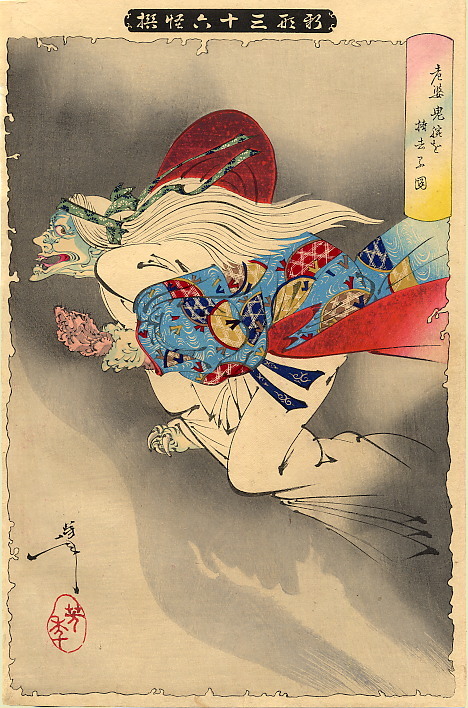
Transformed Ibaraki Dōji, as depicted by Tsukioka Yoshitoshi (wikimedia commons)
The legend of Ibaraki Dōji was evidently reasonably popular in the Edo period, and could even be utilized to comedic ends. One example is an Edo period satirical pamphlet, Thousand Arms of Goddess, Julienned: The Secret Recipe of Our Handmade Soup Stock, written by Shiba Zenkō and illustrated by Kitao Masanobu. Here the one-armed Ibaraki Dōji is one of the figures interested in leasing one of the now detached additional arms of the Thousand-Armed Kannon, who has apparently fallen in dire straits (“business slumps are inevitable, even for a Buddha”, comments the narrator, alluding to the financial conditions of the 1780s). As we learn, after making a purchase Ibaraki is disappointed by the lack of hair, and promptly hires a craftsman to add it:

Original translation by Adam L. Kern; reproduced here for educational purposes only. I am not responsible for the typesetting.
In my recent Ten Desires article I’ve already discussed the oni of Rashomon as a character in legends about Yoshika no Miyako, which I won’t repeat here. It will suffice to say that this conflation effectively made Ibaraki a penchant for poetry and fine arts, and that it indirectly put him in the proximity of the pursuit of immortality. Whether this is why ZUN made Ibaraki’s counterpart a wannabe immortal (“hermit”) is difficult to ascertain, but it does not strike me as impossible.
The oni of Rashomon actually appears in at least one more legend which similarly portrays him as an enthusiast of the arts, though to my best knowledge this one never came to be reassigned to Ibaraki Dōji. It is centered on a famous biwa player, Minamoto no Hiromasa, who has to resolve the case of mysterious theft of an instrument from the imperial palace. As you can expect, it is revealed to specifically be an exceptional biwa, which bears the name Genjō. Hiromasa surveys the city in hopes of finding it, and eventually hears its distinct tones while passing near the Rashomon gate. He quickly realizes an oni is playing it. He politely asks if he can have it back, since it’s a treasure of the imperial court… and the oni eagerly obeys, thus bringing the story to a happy end. However, we are told Genjō acquired supernatural qualities in the aftermath of the theft, and only played when it felt like it, as if it was a living being.
There is a variant which reveals that the oni of Rashomon was in fact the ghost of Genjō’s original maker, a craftsman from India. In this version, Abe no Seimei has to intervene to recover it, and the oni only agrees to return it after being promised a night with a woman he fell in love with who resembles his deceased wife. There is no happy ending here, though, as the woman’s brother convinces her she needs to kill the oni. She fails, and meets such a fate herself instead. It seems that the reader’s sympathy is actually supposed to be with the oni in this case.
Conclusions, or why you should make your own Deva of the Mountain

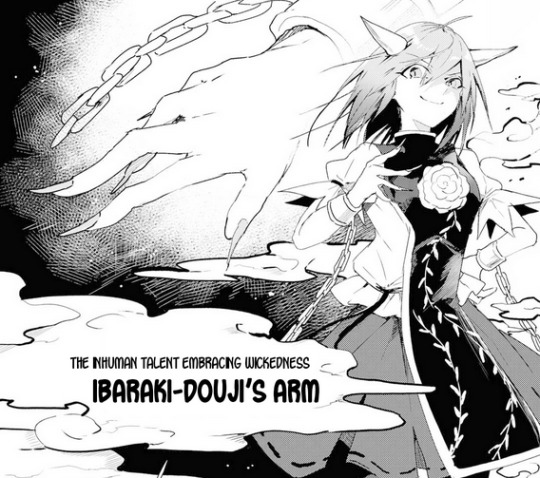
Obviously, there is nothing novel or clever about stating that the two figures this article is focused on, Shuten Dōji and Ibaraki Dōji, correspond to Suika and Kasen respectively. You can learn that from the official media itself, after all. Funnily enough, it seems this might have been even more blunt, judging from unused ideas for referencing the legend to an even greater degree in WaHH, with the defeat at Mt. Ōe as the explanation why oni reside… well, elsewhere (source). Granted, it would also be a disservice to ZUN to say he only created anime girl versions of the classic oni. He effectively created his own versions of both Shuten and Ibaraki - for every similarity between the irl background I’ve described and Touhou, there is also something brand new. That is part of what makes Touhou compelling, I would argue.
Naturally, the fact that the group Kasen and Suika belong to is referred to as the Four Devas of the Mountain shows clear inspiration from the Edo period version of the original legends. However, Suika and Kasen are counted among the four, which is obviously an innovation. Additionally, while Yuugi is naturally named after Hoshikuma Dōji, who you were able to meet earlier, save for the name she is effectively a fully original character. Her ability references the Analects of Confucius, rather than anything directly tied to Shuten Dōji. And, on top of that in all honesty, she has more character than any of the additional oni appearing in the real legends. ZUN, as far as I am concerned, created a more than worthy addition to the classics.
What about the much discussed fourth deva? I think it’s safe to say that in the light of the discussed material there simply isn’t a single most plausible option. As I stressed already, there’s no consistent group of oni appearing alongside Shuten Dōji, and it cannot be said that the Edo period version is clearly what should be treated as true in Touhou. ZUN picked what he liked from many versions.
For what it’s worth, so far all of the oni forming the Four Devas are based on those who share the moniker of dōji, so that’s the closest we have to a theme. As I already said earlier, this term can be simply translated as “child” (or “lad”, though I think a gender neutral option is more apt since we are talking about Touhou here, ultimately). However, it has a more specific meaning when applied to supernatural beings. In this context it refers to a category of ambiguous figures characterized by “vitality, (...) hubris, and (...) unpredictability”, as well as fondness of violence, as summarized by Bernard Faure. Shuten Dōji, and by extension his underlings, are obviously the dōji par excellence. However, the term could also be applied to benevolent, or outright divine beings. That, however, goes beyond the scope of this article.
I personally think despite the possible dōji theme the fourth slot will never be filled, ultimately. ZUN likes leaving gaps in established groups - there are types of tengu which were a part of the background for well over a decade, for instance. I think these are left as paths to make ocs with an instant excuse to interact with canon characters. Despite ZUN’s generally pro-fanwork stance I do not think I’ve ever seen anyone make this point.
As far as I am concerned, the conclusion is clear: it’s entirely fair game to invent characters to fill the empty spot. There’s even a solid case to be made for reinventing oni from other legends as members of the Four Devas - remember that much of Ibaraki Dōji’s character was borrowed from a nameless oni from a legend about the Rashomon gate, as I discussed last month.
Bibliography
Bernard Faure, Rage and Ravage (Gods of Medieval Japan vol. 3)
Michael Daniel Foster, The Book of Yokai. Mysterious Creatures of Japanese Folklore
Adam L. Kern, Thousand Arms of Goddess, Julienned: The Secret Recipe of Our Handmade Soup Stock, written by Shiba Zenkō and illustrated by Kitao Masanobu (translation and commentary), in: An Edo Anthology: Literature from Japan’s Mega-City, 1750–1850
Keller Kimbrough and Haruo Shirane (eds.), Monsters, Animals, and Other Worlds. A Collection of Short Medieval Japanese Tales
Irene H. Lin, The Ideology of Imagination: The Tale of Shuten Dōji as a Kenmon Discourse
Michelle Osterfeld Li, Human of the Heart: Pitiful Oni in Medieval Japan in: The Ashgate Research Companion to Monsters and the Monstrous
Noriko T. Reider, Shuten Dōji: "Drunken Demon"
Idem, Japanese Demon Lore
Idem, Seven Demon Stories from Medieval Japan
also check out the scans of an amazing Shuten Dōji picture scroll from the NYPL collection here!
143 notes
·
View notes
Text
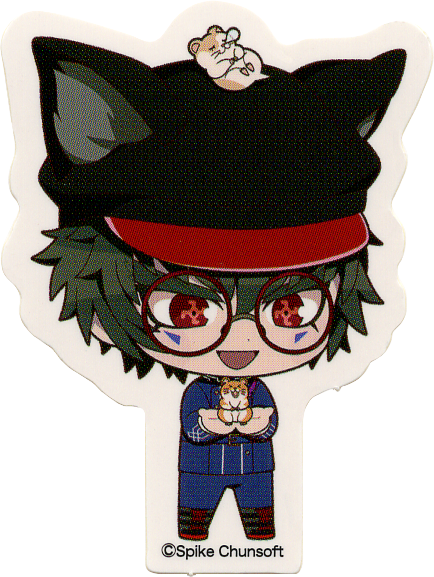


⋆⭒˚。⋆ Danganronpa 1/2 Reload x Master Detective Archives: RAIN CODE CollaboCafé Sticker [Vol.2] (ft. Zilch Alexander) ⋆。˚⭒⋆
[ Filled + adjusted/original die cut ]
#ScanEverything#OfficialEverything#RAIN CODE#MDRAC#Zilch Alexander#Spike Chunsoft#Sticker#Dark devas#Four Dark Devas of Destruction#Danganronpa#SDR2#Super Danganronpa 2#Danganronpa 2: Goodbye Despair#Master Detective Archives: RAIN CODE#Die-cut sticker#Video game merch
20 notes
·
View notes
Text
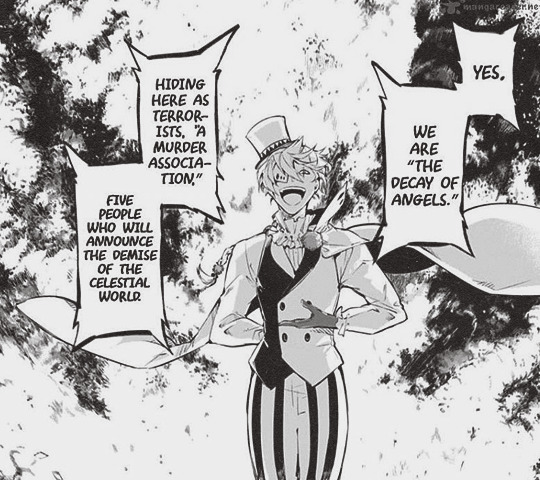
BUNGO STRAY DOGS VS LITERATURE: THE DECAY OF ANGELS
This is going to be the first in a long (long) running series where the goal is to read every single book mentioned by name in Bungo Stray Dogs, and try to connect the themes of that book to the characters who are referencing that book. In light of the recent arc I am starting out with "The Decay of Angels" the villainous organization consisting of Bram Stoker, Nikolai Goggol, Fyodor Dostoevsky, Ochi Fukuchi and Sigma.
The name Decay of Angels comes from Yukio Mishima's novel, the Decay of the Angel. The fourth and last book in his Sea of Fertility tetraology which is widely considered to be his masterpiece. I read all four books, so underneath the cut I'll elaborate on the connections between Yukio Mishima's work and Bungo Stray Dogs.
1. The Decay of the Angel
The Sea of Fertility is a tetralogy of novels written by Japanese AUuhor Yukio Mishima. The four novels are Spring Snow, Runaway Horses, the Temple of Dawn, and the Decay of Angel. The main timeline of the story stretches from 1912 to 1975, the main character of all four books is Shigekuni Honda a law student in Spring Snow, who's best friend Kiyoaki Matsugae dies at the age of twenty at the end of the first book. In each sequel, Shigekuni meet what he believes are the reincarnations of Kiyoaki, who are condemned by karma to die at an early age. Every time he attempts to save them from their deaths he fails.
The strongest connection between the Sea of Fertility itself, and the "Decay of Angels" organization depicted in Bungo Stray dogs is that both are heavily inspired by Buddhist ideology. The Sea of Fertility is an exploration of the concepts of both "reincarnation" and "karma" while the ideology of the decay of angels is to enact Karma in the real world for the past sins of the governing body.
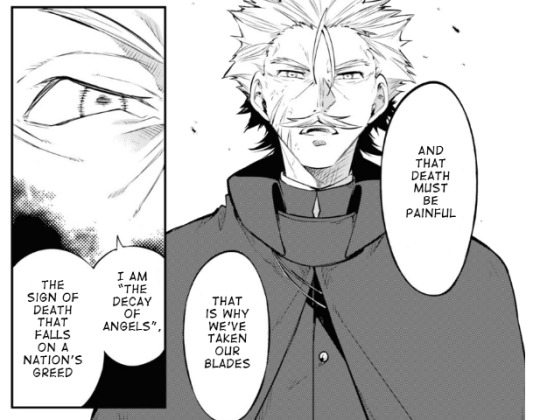
The brihadarankyaka Upanishad states: Indeed the person performing a good deed will become benevolent, and one performing a bad deed will bcome evil; one becomes pure by pure acts, and black by evil acts. Therefore it is said: a human being is composed of karma, or "desire" by following karma one creates will, by following will one creates karma, and through karma, samsara comes into existence."
The Temple of Dawn
Both the ideology of the Decay of Angels, and Yukio Mishima's work make constant references to budhism like this. Budhists conceive of the world as a suffering-laden sycle of life, death and rebirth without beginning or end known as Samsara. In essence in budhism, beings are driven from life to life in this system by karma which is activated by good or ill actions committed in this life as well as previous lives. Fukuchi's goal is more or less to make Karma real and enact it with his hand, to punish governing bodies for their past sins.

His ideals are also heavily budhist in nature, more or less budhists believe suffering in inherent to life. The goal of budhism is actually to stop being reborn and escape the cycle of death and rebirth by eventually purifying yourself of earthly desires, etc. etc. Fukuchi's goals allign with these ideas. Just like reality and earthly desires inherently cause suffering. As long as governments exists, they will continue to create war. The only way forward is to create a death and rebirth. Governments have to die, so society as a whole can be reborn into a higher, more enlightened state. He is essentially twisting lofty budhist ideals to justify his extreme political actions.

Bungo Stray dogs also borrows some symbolism from the fourth book, the Decay of the Angel. In budhist scripture Devas are mortal angels. A topic the fourth book discusses at length.
Here is the account in the twenty fourth fascicle of the Ekottara-augama: "There are thirty-three angels and one arch angel, and the signs of death in them are fivefold. Their flowered crowns wither, their robes are soiled, the hollows under their arms are fetid, the body ceases to give off light, it loses awareness of itself."
Decay of the Angel

There are five members of the decay of angels in BSD, Fukuchi, Fyodor, Goggol, Bram, and Sigma, just like the five stages of decay. Just as in budhist belief death comes for everything, even the angels, the stated goal of the organization is to bring death to the members of the world's government. Quite literally in Fukuchi's case, by controlling a vampire army (vampires being symbols of death due to being undead and bloodsuckers themselves).
2. Death and Rebirth
The main premise of the Sea of Fertility is tracking the four reincarnations of one individual. Each successive reincarnation lives a short life and dies for the sake of an ideal.
'Kiyoaki Matsugae was caught by unpredictable love, Isao Iiinuam by destiny, Ying Chan by the flesh. And you? By a baseless sense of being different, perhaps? If destiny is something that takes hold of a person and drags him after, then the other three had desinty. And has anything caught you?'
The Decay of the Angel
The whole organization of Decay of Angels, is seeking a somewhat symbolic death and rebirth of society, but at the same time as individuals four members are seeking to die for the sake of an ideal like the four lifetimes of Kiyoaki.

Gogol's may seem to be the simplest, to commit suicide in order to free himself entirely from god's will. He may be a russian character, but even some of his ideals are budhist. One of the major differences between Budhism and Hinduism as commented on in the books, is that Hinduism believes in the divine whereas in Budhism there are no gods. Not only do they reject gods, but they also reject the idea of a "soul."
"Budhism does not recognize the soul as such. If there is no core substance called soul in beings, there is of course, none in organic matter. Indeed quite like a jellfyfish devoid of bone there is no innate essence in all of creation. . If we assume there is no self, what is the basis of the birth-and-death cycle to start with?... WHen the Threavada Sautranika school evolved the concept of "seed perfurming" was established according to which the effect of a good or bad deed remains in ones consciousness, permeating it as the fragnace of perfume permeates clothes and thus forms character."
Gogol's ideal is similiar to that belief, he rejects both the idea of god, and the idea of his soul, in order to prove that all that exists of the universe is his free will and consciousness. He even goes through a metaphorical death and rebirth in order to reach that ideal, he fakes his own death, and then is revealed to be alive.
There's even a discussion of free will in several of the books, particularly the fourth.
"He should have armed them with the foreknowledge that would keep them from flinging themselves after their destinies, take awaay their wings, keep them from soaring, making them march in step with the crowd. The world does not approve of flying. Wings are dangerous weapons. They invite self-dstruction before they can be used."
Decay of the Angel
If you wanted to parallel him to one of the lifetimes, you could even say he is much like Kiyoaki, someone caught up in an unpredictable love. At one point in the story, as he's dying of sickness he continues to try to visit his lady love every day for the sake of seeing her one last time and considers facing his impending death to be a trial to prove his love. Gogol similiarly puts his closest friend through a life or death trial to see if his feelings spring forth from himself and his own free will, or are brainwashing.

"I'd tell myself in it was because I was insincere. I'd know in my heart that if only I had gotten out of the rickshaw and walked, no matter how weak I felt, then such sincerity - even if she was unaware of it - would have affected her, and she would have seen me. That's it then. There's no reason to have such regrets. I have no other choice but to risk my life, if I want to see her. To me, she's the essence of beauty. ANd it's only that which has brought me so far."
-Spring Snow
The second lifetime lived by Kyoaki is that of Inao who is a far-right extremist in Japan, who wishes to see japan return to its more imperialist ideals. As a whole these novels take place over a time frame that's post the russo-japanese wars, all the way to the lead up into world war two, and then post world war two. There are pretty obvious references to world war two (the island where Fukuchi fought on being a reference to Okinawa, Ahabaraki being a reference to the nuclear bomb). Bungo Stray Dogs also clearly takes place in a post-war society. The motivation of the current villain Fukuchi is the mistreatment of soldiers during that previous war.
Fukuchi resembles Isao, the far right extremist. In the second book there is a long recounting of the history of the Satsuma Rebellion. It was a revolt of disaffected samurai against the new imperial government, nine years into the Meiji Era. In the book it’s mentioned they prayed at a shrine a number of times, and waited to rebel until they believed the god’s themselves approved of their rebellion. The main character of the book Isao wants to enact a similar rebellion against the government to rid Japan of western influence and to make the emperor all powerful again.
The sins I refer to have nothing to do with the law. And the greatest sin is that of a man who, finding himself in a world where the sacred light of His Majesty is obscured, neverthless determines to go on living without doing anything about it. The way to purge this grave sin is to make a fiery offering with one's own hand, even if that itself is a sin, to express one's loyalty in action, and then commit seppuku immediately. With death, all is purified
Runaway Horses
The goal of the main character is to "before the sun... at the top of a cliff at sunrise, while paying reverence to the sun... while looking down upon the sparkling sea, beneath a tall, noble pine... to kill myself..." He is a man who wants to commit a sin he believes will put his country on the right track, and then die for his country. He also believes the only way forward is a military coup (guess what happens in japan in a couple of years). Fukuchi's goal may be the opposite, but he still uses the same methodology. He has seized full and total control of the world's governments acting as an ultimate emperor to achieve his goal. Everyone else is just instruments and puppets to him, he literally changes them into mindless zombies.
"Here was the power of the emperor himself. Only on this drill ground was the hand of the sun working with a mathematical clarity and precision. Only here! The will of the emperor penetrated the sweat, the blood, the very flesh of these young men, piercing their bodies like X-Rays."
Runaway Horses
Fukuchi's goal is essentially to fight imperialism by using tools of imperialism himself. He also invokes the divine when fighting against Akutagawa and Atsushi, saying he carries and enacts the divine will. He is focusing all power on himself, the same way Isao wished for the emperor to have total control and authority of the country once more to purge out western, socialist, and capitalist influence.

He also, just like Nikolai experiences a death and rebirth on the battlefield. Fukuchi was once manipulated like Isao by far-right ideals that joining the military would equate to protecting both his comrades and his countries, only to be eaten up and chewed out by the war-machine and not accomplishing protecting anyone but the governments already in place, creating the current Fukuchi.


Just like the deaths of his comrades were wasted, Isao also experiences a disapopinting suicide which is the exact opposite of what he wanted, and the ideal of dying with honor presented throughout the story. Which clearly illsutrates all the militaristic and far-right ideals Isao believed in through the story, were proven false and nil by the end.
“The sun will not rise for some time,” Isao said to himself, “and I can’t afford to wait. There is no shining disk climbing upwards. There is no noble pine to shelter me. Nor is there a sparkling sea.”
Runaway Horses
The third book features Thai Princess Ying Chan who is said to have been caught by the flesh. This will be the shortest section because the third book is very dark, but basically the third book the Temple of Dawn deals with how the elder generation of japan, preys upon and takes advantage of the youth. Ying Chan because of her youthful body, is molested by two adults who she trusts.
Sigma is someone similiar to Ying Chan, a youth who is born and then continually used by everyone around him in his life. He is the ultimate child taken advantage of by society passed over again and again due to being born from "nothing."


The last reincarnation depicted in the fourth book "The Decay of the Angel" deals heavily with themes of nihilism, and deeply resembles Dostoevsky. Especially if you believe Fyodor is in part an adaptation of Raskolnikov's theory that truly great people should be above morality as depicted in crime and punishment.
Toru's goal in the Decay of Angels, is to devote himself to a pure form of evil and get lost in the pursuit of it. He is depicted as a twenty year old exceptionally brilliant individual who does not form relationships, is detached from the society around them, has no strong pursuits except for this, and his highly nihilistic believes. The kind of nihilism that is portrayed for its flaws in many of Dostoevsky's works.
"My purity will presently wander beyond the horizon to that invisible realm. Probably not on the end of unbearable pain, I shall seek to become a god. The pain! I will know of it, the pain of absolute silence, a world of nothing at all. I will crouch in the corner, like a sick dog. And the happy ones will sing songs around me. There is no medicine for it. No hospital. It will be written in tiny gold letters somewhere in the history of the race: that I was evil."
Which mirrors the description of Fyodor in his introduction as something "Darker than evil, something horrifying."
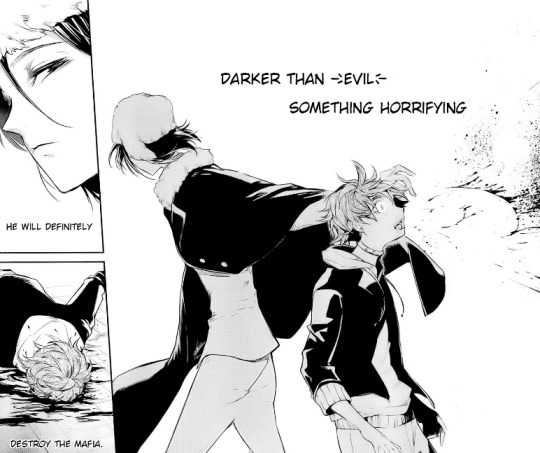
Fyodor is also someone with a large blind spot when it comes to ordinary people, this is something he is lectured on by Dazai. That he believes he has enough control like a player sitting outside of the gameboard that he can control the movment of every single piece. That the world is controlled by great people manipulating it. Whereas Dazai's beliefs are the world is controlled by everyone's actions moving together in an unpredictable fashion, rather than a god sitting outside manipulating things.

Toru receives a similar lecture because he bbelieves himself to be some kind of great man due only to his extra intelligence and how isolated he is from others.
"There is no special right to happiness and none to unhappinnes. There is no tragedy and there is no genius. Your confidence and your dreams are groundless. If there is on this earth something exceptional, special beauty or special evil, nature finds it out and uproots it. You thought didn't you, that you were a genius beyond compensation. You thought of yourself, didn't you, as a beautiful little cloud of evil floating over humanity."
The Decay of the Angel
Which seems to be the lesson that the story is going in the direction of teaching Fyodor, that there is no such thing as inherent specialness, exceptional people, gods or demons.
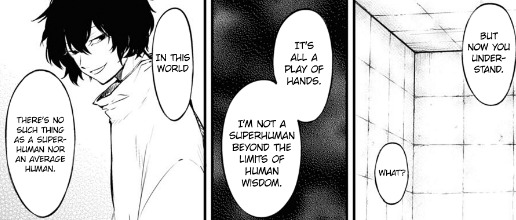
Fyodor is also someone who while he has no undergone a death himself, his goal is to deal death, which he seems to be able to do with just a touch of his hands, in order to make the world reborn into a “world without the evil of ability users”. Death, birth, and rebirth are themes that are strong with all five of these characters.

As for Bram he’s the character we know the least about, but I would say while Fyodor, Fukuchi, Gogol and Sigma can be equated to individual lifetimes of Kyoaki, Bram himself being an immortal vampire and oldest of the group is much like Honda who is an outsider and witnessing the lives of young people being reborn over and over again. Especially since by the fourth book he is eighty years old and essentially a helpless elder. The various lifetimes of Kiyoaki die young, he lives on a much emptier life than any of them. Bram’s just a head. He’s the most helpless of the whole group. He’s just a witness to all of this. But he’s also an immortal vampire, so therefore an outsider to the cycle of death and rebirth.
Well, that is all I have to say about “The Decay of the Angel” and the connection to the “Decay of Angels” depicted in Bungo Stray Dogs, and the five members who make it up. I fully reccomend picking up the book, just as Bungou Stray Dogs is shaping up to be anti-war in its text and the depiction of several successive generations (the war generation, the post war, the Sea of Fertility is a massive work referred to as “the most complete vision we have of Japan in the 20th Century” by Paul Theroux. It deals with similiar themes in BSD of the changes between generations, the shift in society of japan in the last century, the influence of imperialism. If you want to pick it up and read it, it comes highly recommended by me!
#bsd meta#bungou stray dogs meta#bungou stray dogs theory#bungou stray dogs#bungou stray dogs analysis#fyodor dostoevsky#bsd fyodor#nikolai gogol#bsd gogol#fukuchi ochi#sigma#literature analysis#the decay of angels#yukio mishima#decay of angels#doa
350 notes
·
View notes
Text
Warning;: smut discussion. Nsfw
Inspired by a very specific scene from Fellow Travellers.
So ..this guy (let's call him xyz) from work hits on Varadha casually. ..like not even flirting .. Just a casual how you doing...
Varadha comes home from work and tells Deva about the new friend at work and how he's really friendly and nice....Deva just grunts a monosyllabic uh-huh
Cut to few minutes later
Deva (thrusting inside Varadha): Who do you belong to?? Say it.
Varadha (panting): You..you...oh my God...you!!!
Deva(increasing his pace, literally ramming into Varadha) : Say my name..
Varadha (almost losing it): Deva..Devaaa!!!!
Deva (at the brink ): Say the full name. Say it!!
Varadha(vision blurring, at the edge..like seconds away): DEVA..RATHA..RA..I.SAR!!!
And then they're both gone!!!
#salaar#varadeva#varadeva au#varadha#deva#i'll go hide in a corner now#fellow travellers#thank you matt bomer and jonathan bailey!!#pls forgive me if this seems really oof#but I couldn't resist picturing varadeva in this scene#bye!!
40 notes
·
View notes